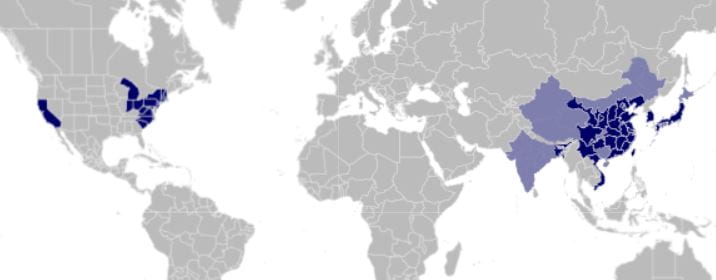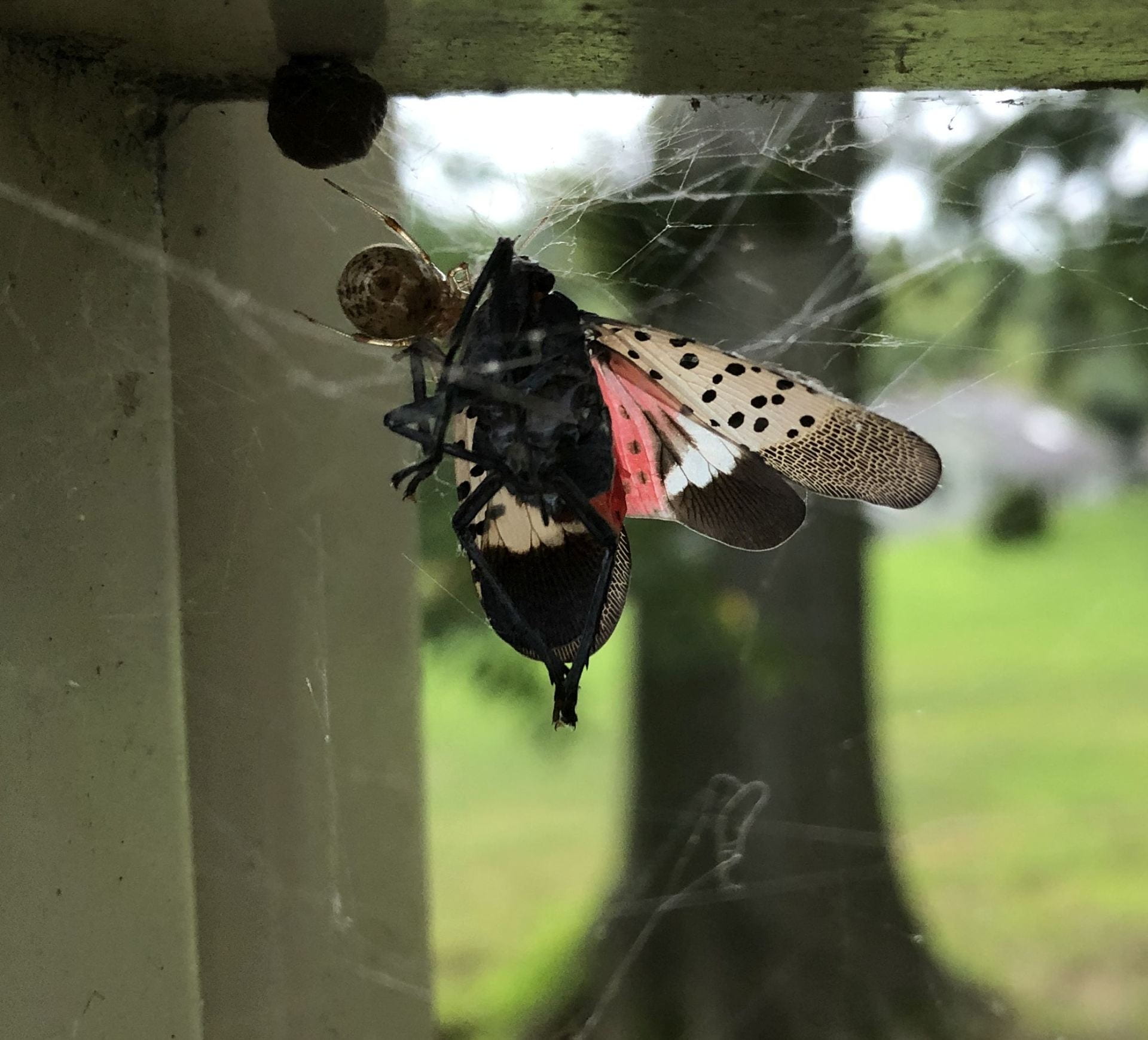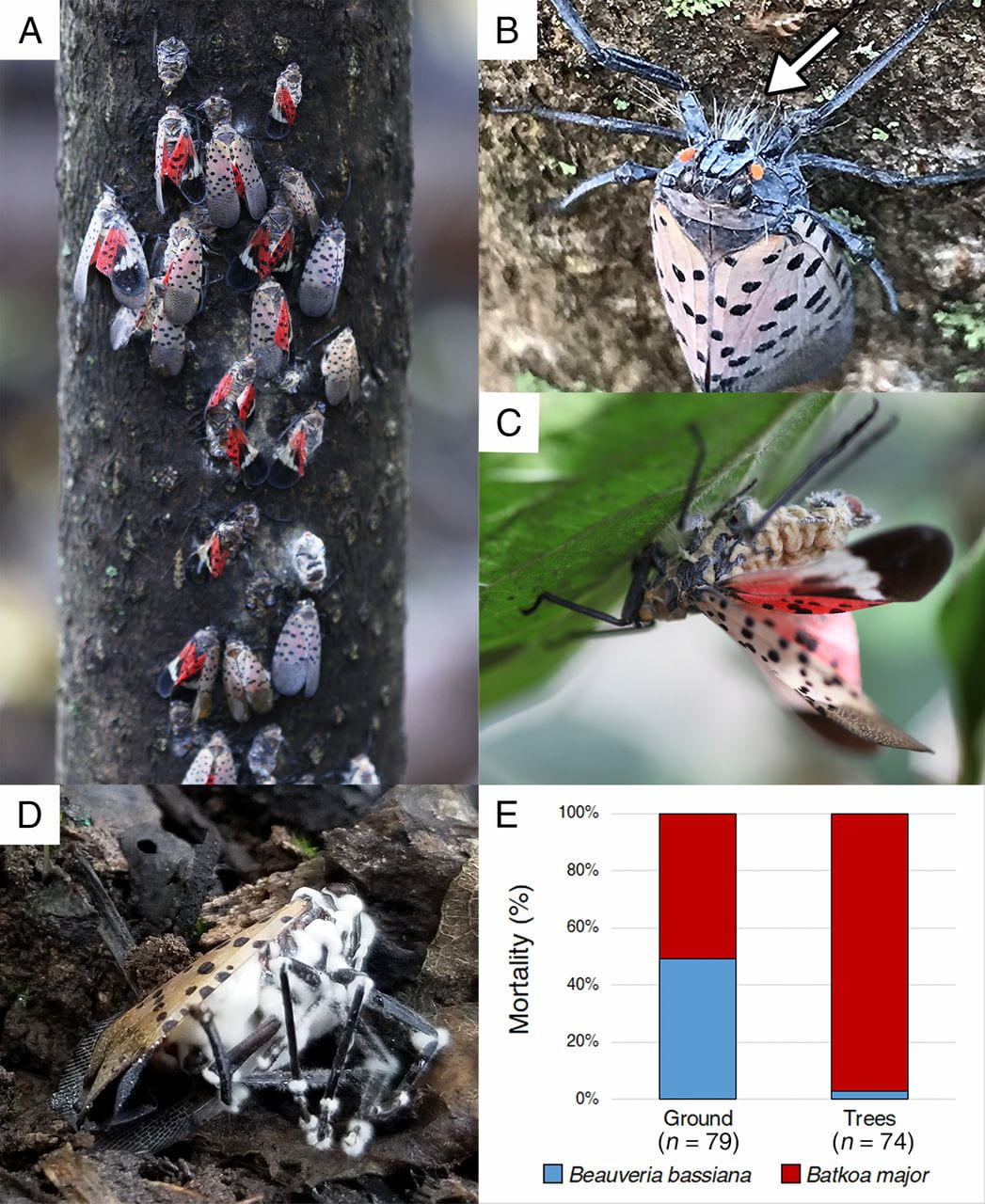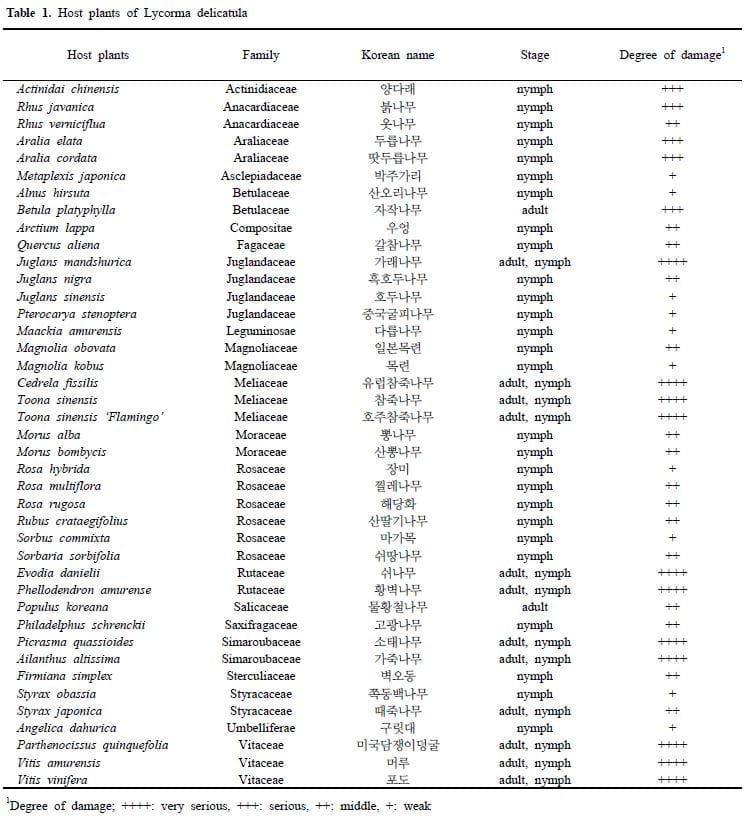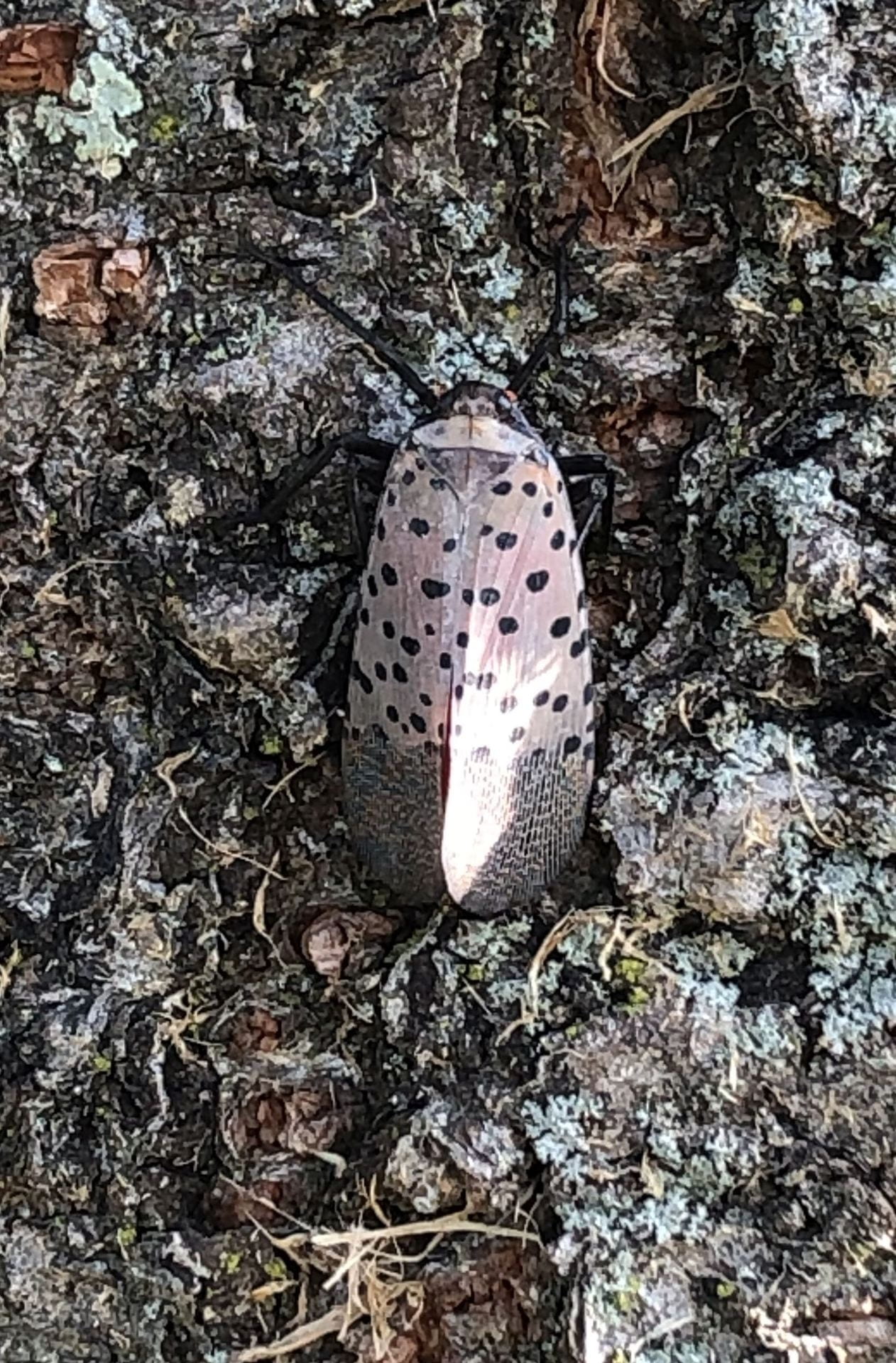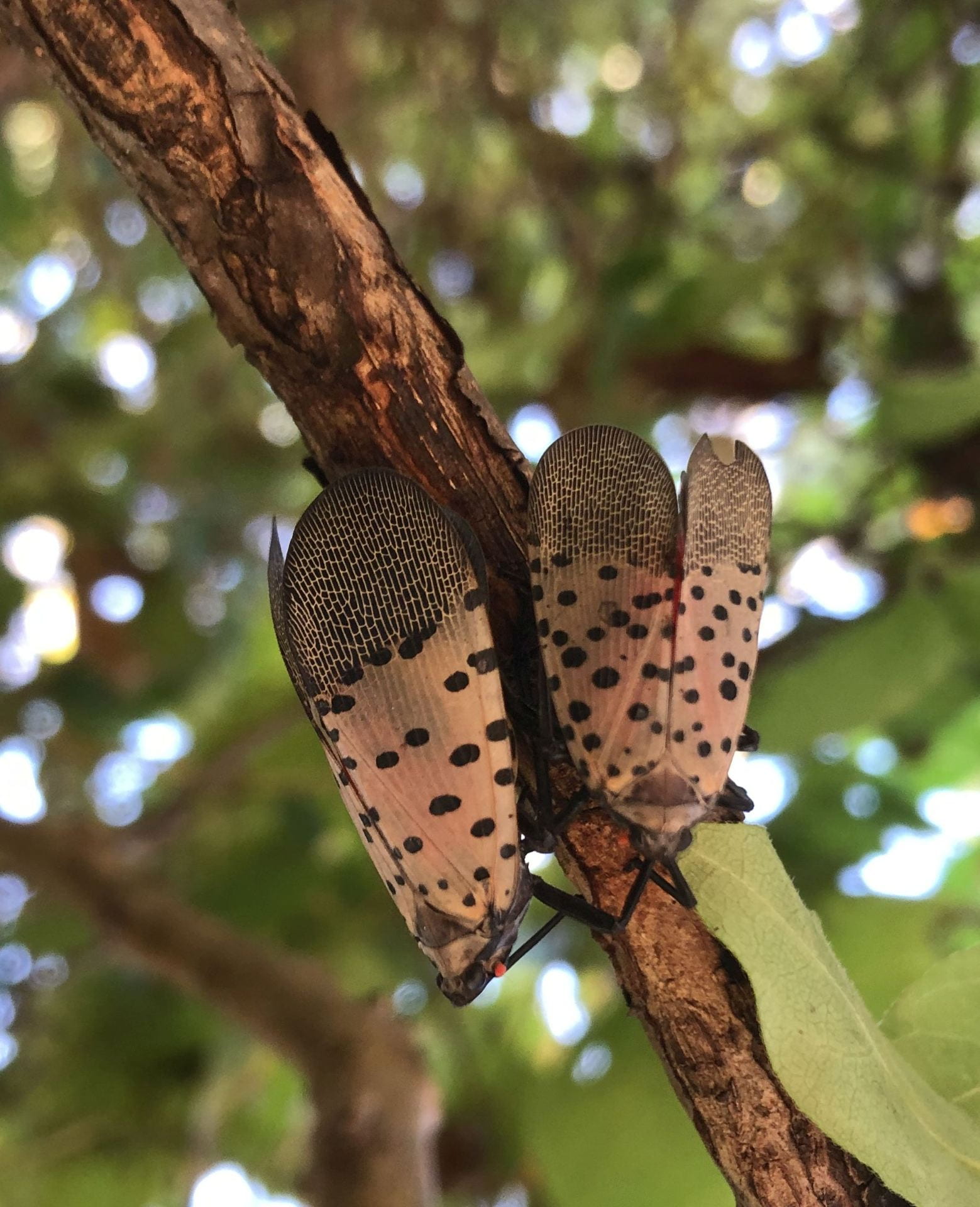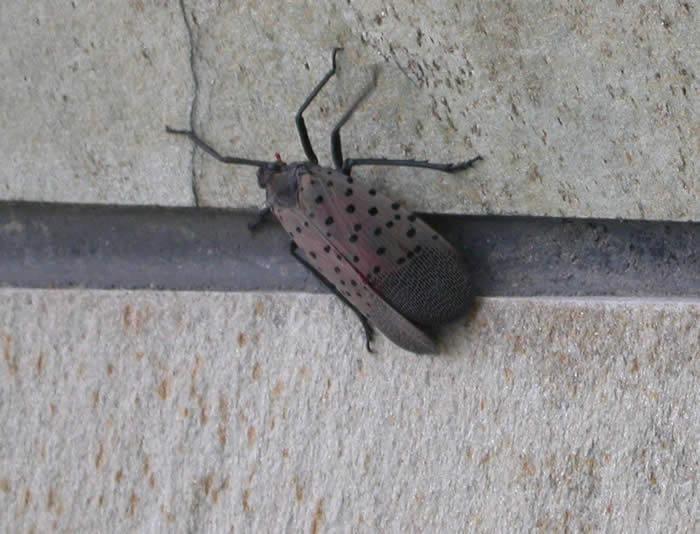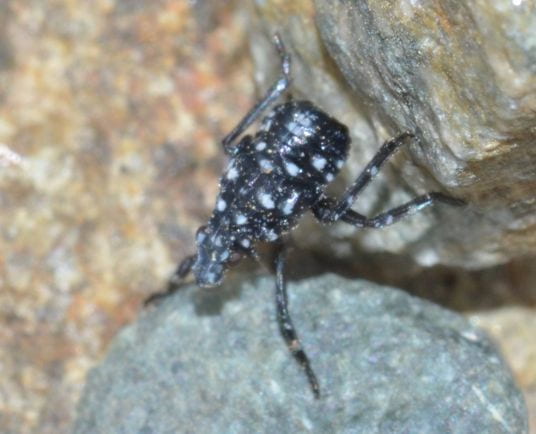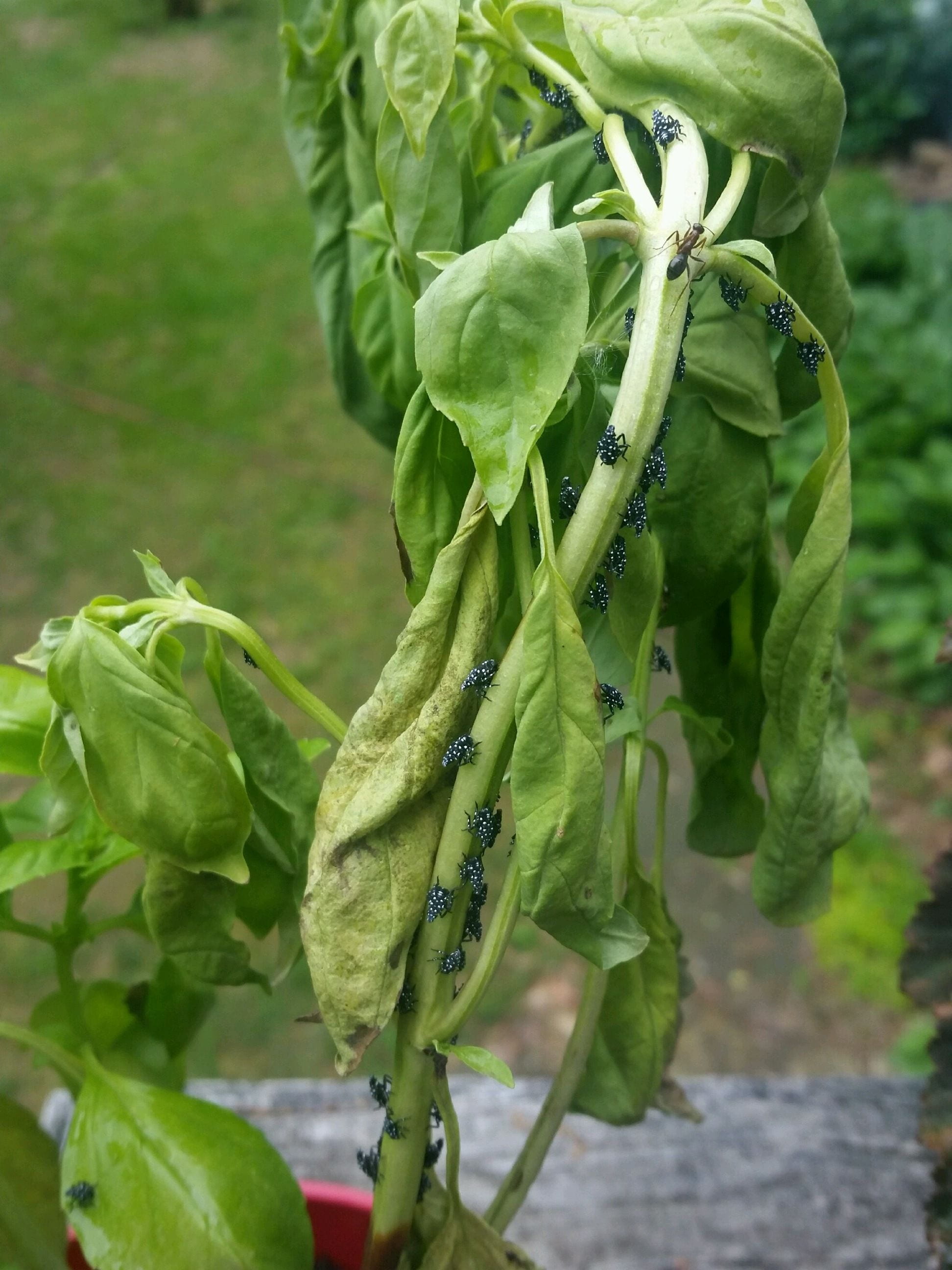[back to North American Fulgoridae]
Contents
- 1 Family Fulgoridae Latreille, 1807
Family Fulgoridae Latreille, 1807
Subfamily Aphaeninae Blanchard, 1847
Tribe Aphaenini Blanchard, 1847
Genus Lycorma Stål, 1863: 234.
Type species (in original combination): Aphana imperialis White, 1846: 330.
Synonyms: None.
Recognized species
[Genus Lycorma in Metcalf catalog – Metcalf 1947: 163], see also 3i TaxonPages]. The taxonomy below adopts the view of Nagai & Porion (1996), updated by Lin et al. (2023), of Lycorma consisting of four species and no subspecies.
Lycorma delicatula (White, 1845) (Spotted lanternfly, SLF) – Bangladesh, China (Anhui, Beijing Fujian, Gansu, Guangdong, Hebei, Henan, Hubei, Jiangsu, Shaanxi, Shandong, Sichuan, Tianjin, Yunnan, Zhejiang); Japan (Honshu, Kyushu); Nansei-Shoto (Ryukyu Islands), South Korea; Vietnam; USA (currently 17 states plus 2, maybe 3, on iNaturalist – DE, CT, GA, IL, IN, KY, MA, MD, MI, NC, NH, NJ, NY, OH, OR, PA, RI, SC, TN, VA, WV; individual records (not populations) in Vermont, New Hampshire, Wisconsin, Missouri, Florida, Utah, Montana, Texas, Florida. and California); Also Ontario and Nova Scotia in Canada.
Nymphs were reported from Portland Oregon on iNaturalist.
= Aphaena delicatula White, 1845: 37.
= Lycorma delicatula (White, 1845), comb. by Stål 1863: 234.
= Lycorma delicatulum (White, 1845) incorrect subsequent spelling of Lycorma delicatula (White, 1845) in Matsumura 1931: 1269.
= Lycorma jole Stål, 1863: 234 (subjective synonym of Aphaena delicatula White, 1845) in Nagai & Porion, 1996a: 21.
= Lycorma operosa (Walker, 1858: 46) (subjective synonym of Aphaena delicatula White, 1845) in Nagai & Porion, 1996a: 21.
Lycorma imperialis (White, 1846: 330) – Bangladesh, India (Assam, Darjiling, Sillim), China
= Aphana imperialis White, 1846: 330.
= Aphaena imperialis (White, 1846), comb. by Westwood 1848: 74.
= Lycorma imperialis (White, 1846), comb. by Stål 1863: 234.
= Aphaena placabilis Walker, 1858.
= Lycorma imperialis placabilis (Walker, 1858), comb. by Distant 1906: 206.
= Lycorma imperialis var. placabilis (Walker, 1858), comb. by Metcalf 1947: 166.
= Lycorma imperialis var. placabilis (Walker, 1858) synonym of Lycorma imperialis (White, 1846) by Nagai & Porion 1996: 21.
Lycorma meliae Kato, 1929 – Taiwan
= Lycorma olivacea Kato, 1929, synonym by Lin et al. (2023: 13).
Lycorma punicea (Hope, 1843) – Bangladesh (as “Silhet”), China, India (Assam)
= Lystra punicea Hope, 1843: 133.
= Aphana punicea (Hope, 1843), comb. by Schaum 1850: 66.
= Aphaena delectabilis Walker, 1858.
= Aphaena delectabilis Walker, 1858, a synonym of Lycorma punicea (Hope, 1843) by Stål 1862: 485.
= Lycorma punicea (Hope, 1843), comb. by Stål 1863: 234.
= Lycorma imperialis punicea (Hope, 1843), revised status (subspecies) by Lallemand 1963: 45. (error, punicea predates imperialus).
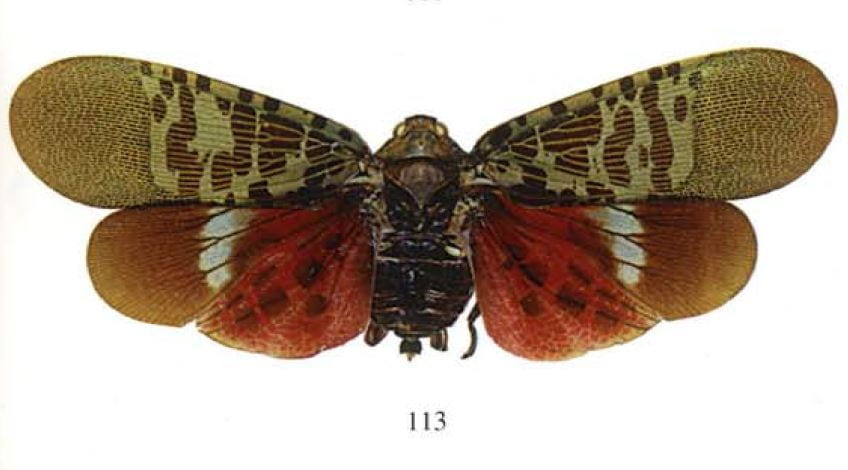
lycorma imperialis from Nagai and Porion 1996 (more iNaturalist)
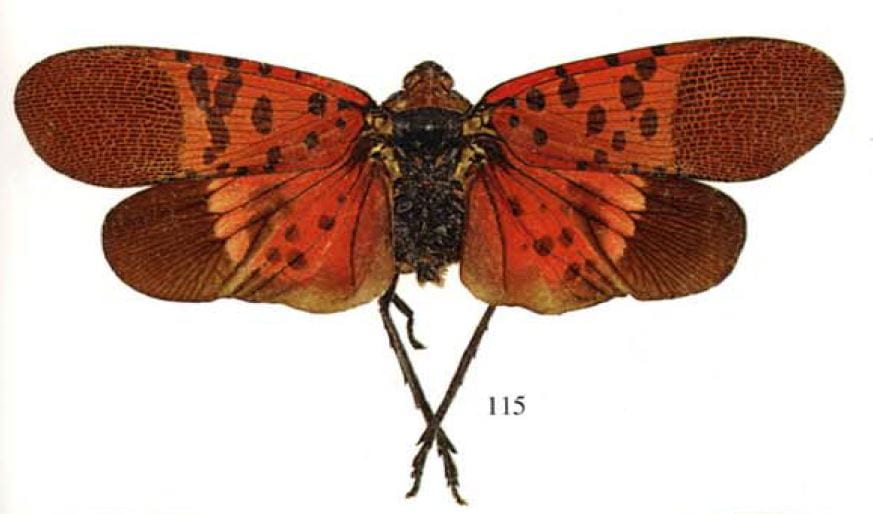
Lycorma meliae from Nagai and Porion 1996 (more iNaturalist)
Distribution
Primarily Indomalayan (for genus), but also temperate China. One species – Lycorma delicatula, the spotted lanternfly [SLF] – adventive to Korea, Japan and USA.
Spotted lanternfly in the US
StopSLF.org is now live, a hub for Spotted Lanternfly information.
SLF in the NYT.
Penn State Extension for SLF.
Homeowner control recommendations (Penn State University Extension) – fact sheet with the current (30 June 2020) recommendations for residents: https://extension.psu.edu/spotted-lanternfly-management-for-homeowners.
SLF Detection map: see Cornell. This map is ‘official’ so may omit reports that state agencies haven’t seen or confirmed.
An article to explain the many options: https://extension.psu.edu/what-to-do-about-spotted-lanternfly-on-ornamental-trees-and-plants-in-residential-and-public-landscapes
There are now many websites on the spotted lanternfly. now too many to list here. See “stop SLF ” which is intended as a clearinghouse of information..
California – no populations, but there have been several accounts of dead adults (or not-so-dead) arriving on aircraft. CA dept. of Ag is taking the threat seriously; Mark Hoddle of UCR Riverside is working on it.
Connecticut (populations in Fairfield & New Haven Counties); reports widespread.
Delaware (all 3 counties).
Indiana. Switzerland County (report new findings in Indiana to the Indiana Department of Natural Resources. Call 866-NO EXOTIC (866-663-9684) or email DEPP@dnr.IN.gov).
Maryland – Now reported in 11 counties, the entire northern border of the state (except westernmost counties of Allegany and Garret), and the adjacent counties. It soon will be easier to list the counties it is not found in.
Massachusetts. Now in Worchester County (see MASS DAR). (pdf in case it gets archived – 22 Feb 2019 – dead specimen, Boston) (see also PDF)
New Jersey – NJ Dept of Ag – Essentially statewide, Cape May County does not yet have a reported population.
New York – Dept. of Ag and Markets, Dept. of Environmental Conservation (Southeast corner of state plus Tomkins and Broome).
North Carolina – They have shown up in the state (dead or mostly dead), but no confirmed populations (NCDA SpottedLanternflyPestWatch.pdf (ncagr.gov)).
Ohio (populations in Cuyahoga and Jefferson Counties), see Ohio Department of Agriculture.
Pennsylvania – All of southeastern Pennsylvania and west along PA turnpike to Ohio border)- updates here; (map updated here: https://nysipm.cornell.edu/environment/invasive-species-exotic-pests/spotted-lanternfly/).
Rhode Island – Detected in Warwick, but not a population yet, maybe (If you have found one, report it here).
Virginia – 6 counties in the northern part of the state (the population was detected in Frederick County, Virginia, on Jan. 10, 2018).
West Virginia – 4 counties in the eastern part of the state
State-level information and reporting
General steps you may take:
Collect a specimen: Turn the adult specimen or egg mass into your state’s department Entomology Lab for verification. First, place the sample in alcohol or hand sanitizer in a leak-proof container.
Take a picture: Submit photographs to the local cooperative extension service.
Report a site: Call the local Bad Bug hotline with details of the siting and your contact information.
Economic Importance
Lycorma delicatula was found in Berks Co., Pennsylvania. In September 2014, the Pennsylvania Department of Agriculture has confirmed the presence of Lycorma delicatula (White, 1845) near Reading, PA. This species probably came from South Korea, and may have arrived 2 years before (hence 2013 or maybe 2012).
Lycorma delicatula arrived in South Korea in 2006 (and subsequently Japan) (see Han et al. 2008), where it has become broadly established. The primary host of the species is the tree of heaven (Ailanthus altissima) but feeds/reproduces on a variety of plants (mostly trees). Particularly troublesome is that grapes (Vitis sp) are a particularly preferred host, but a number of tree fruits (apple, cherry, peach) are on the host list as well. The species sequesters toxins (esp. from its preferred host) and generally, birds will not consume this species.
Unfortunately, this species has been found in large numbers in a Pennsylvania apple orchard – a worrisome observation whose implications are not yet clear. At least 2 vineyards have been lost due to spotted lanternfly in the invasion area.
Webpage from PA Department of Agriculture on Lycorma detection and control efforts.
There is some concern that bees may collect honeydew from Lycorma (Lycorma delicatula and honey bees – honeydew).
Parasites and Predators
Known to be parasitized by a eupelmid wasp Anastatus orientalis (which is an egg parasite, see Kim et al. 2011, Choi et al. 2014 cited below) and a dryinid wasp now under the name Dryinus sinicus Olmi, 1987. Other Dryinus species are also reported as parasites/possible parasites of Lycorma or related taxa. There is some evident of recruitment of egg parasites – several taxa have been reared from SLF eggs, but mostly isolated individuals. Recently, the indigenous Anastatus species, A. reduvii (a parasite of brown marmorated stink bug eggs), has been reared from SLF eggs in numbers, but the parasitism rate remains low (>1%).
There are a variety of reports of insects and birds eating spotted lanternflies. It does appear that wheel bugs (Arilus cristatus (L.), mantids, spiders and the predatory stink bug Apoecilus cynicus (Say) (Barringer and Smyers 2016) will take them.
Recently Clifton et al. (2019) reported a large die-off of spotted lanternfly caused by an coepizootic of two fungal pathogens – Batkoa major (Division Zoopagomycota, Order Entomophthorales) and Beauveria bassiana (Division Ascomycota, Order Hypocreales).
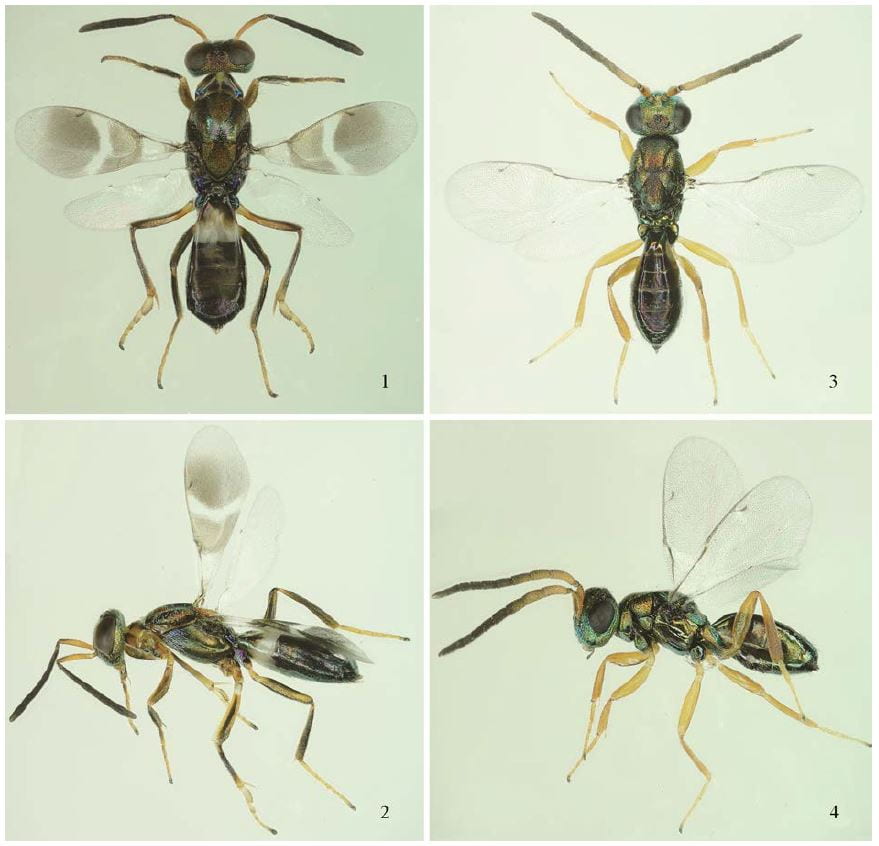
Figs 1–4 from Yang et al 2015: Anastatus orientalis Yang & Choi, sp. nov., fresh specimens. 1. ♀, whole body, dorsal view. 2. ♀, whole body, lateral view. 3. ♂, whole body, dorsal view. 4. ♂, whole body, lateral view.
Ooencyrtus kuvanae (Howard) (Encyrtidae)has been reared from eggs of SLF in Pennsylvania (Liu & Mottern 2017).

Figure 1 from Liu & Mottern (2017). (A) Lycorma delicatula egg masses on bark of sweet birch; inset showing L. delicatula adult. (B) Lycorma delicatula egg mass with arrow indicating Ooencyrtus kuvanae female; inset showing L. delicatula eggs with parasitoid emergence holes. (C) Ooencyrtus kuvanae, female habitus. Arrow indicating exposed portion of ovipositor sheath. (D) Ooencyrtus kuvanae, male habitus. (E) Ooencyrtus kuvanae, female antenna. (F) Ooencyrtus kuvanae, female showing relative sculpture of the midlobe of the mesoscutum (mlm) and the mesoscutellum (msc).
Figure 1 from Clifton et al. 2019: Two fungal pathogens causing a coepizootic in an L. delicatula population. (A) L. delicatula during the epizootic: only one of these adults was alive and the remainder had been killed by B. major. A similar degree of mortality was observed on trees throughout the site. (B) Rhizoids from B. major (arrow) attaching a dead adult to a tree. Image courtesy of Kelly Murman (photographer). (C) Adult cadaver with wings and legs extended outward as B. major conidia are released from the abdomen. (D) Adult killed by B. bassiana. (E) Percent L. delicatula killed by either pathogen on the trees or surrounding ground.
Plant associations
Lycorma meliae Kato, 1929 – Melia azedarach L. (Sapindales, Meliaceae) according to Kato (1933)
The primary hosts for Lycorma delicatula appear to be Ailanthus and grape. The EPPO host list has been updated for SLF (PDF).
Working spotted lanternfly host list from Lawrence Barrenger of PDI (as of 1 Aug 2019)
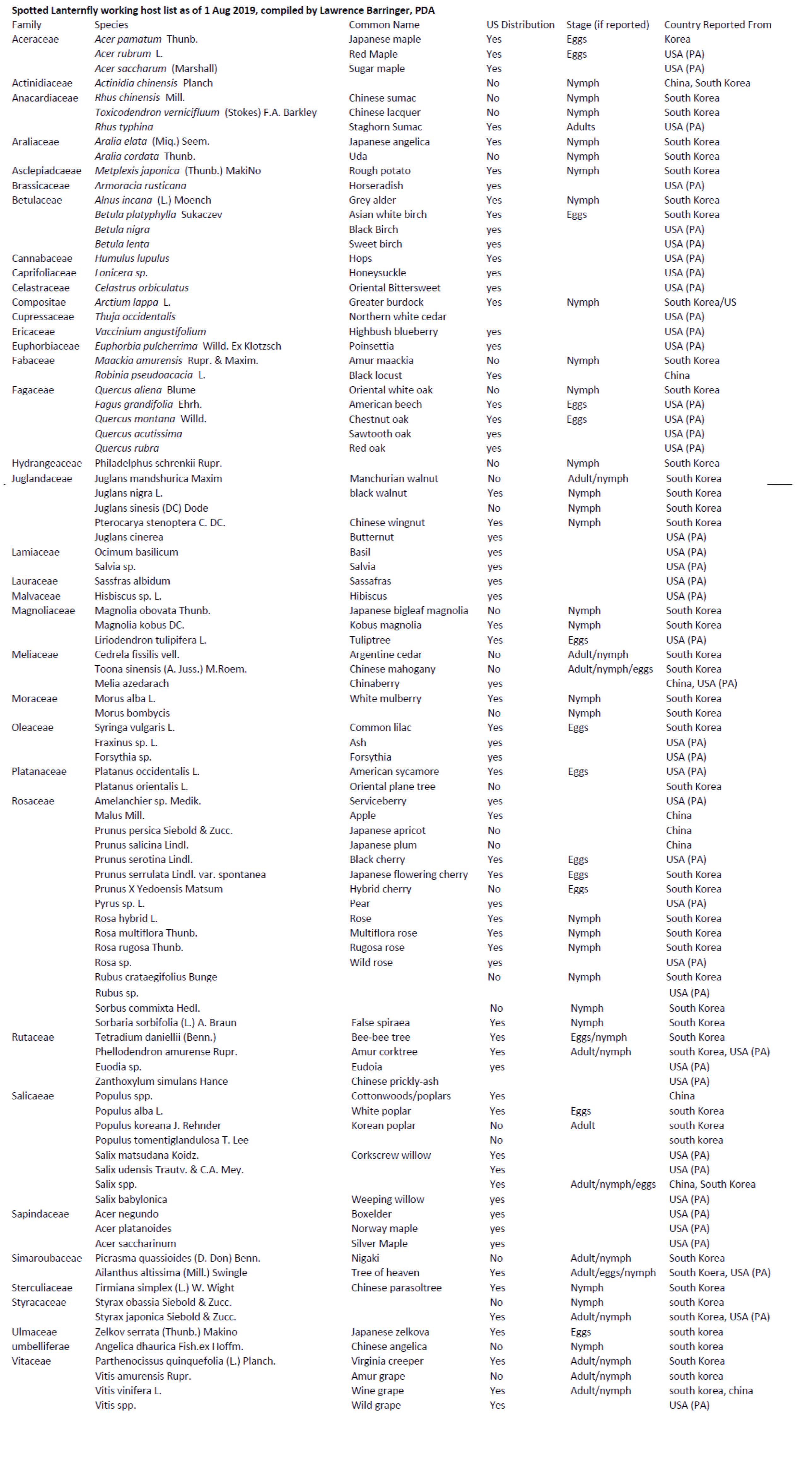
Spotted lanternfly host list, unpublished from L. Barringer, PA Dept. Agriculture (published in Barringer and Ciafré 2020.
Host table from Park et al. (2009).
Recognition
There are no other species in our area similar to Lycorma.
Below, Lycorma delicatula, first instar, photographed in Berks Co., PA on May 12, 2015 by Greg Hoover, Dept. of Entomology, Penn State University
Lycorma delicatula, first instar, photographed in Berks Co., PA on May 12, 2015 by Greg Hoover, Dept. of Entomology, Penn State University
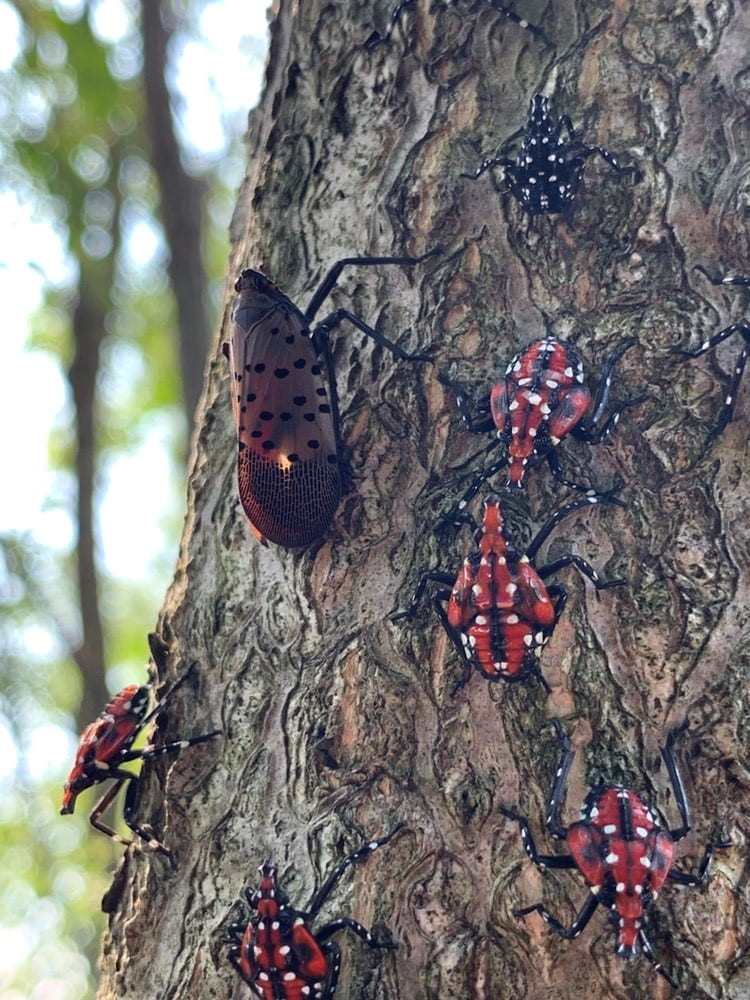
Third and fourth instar spotted lanternfly nymphs with an adult, taken July 9, 2019, at Winchester, VA.
Online Resources
3i TaxonPages.
EPPO.
PDA.
Pest news.
CDFA.
EOL.
Massachusetts Massachusets introduced pest outreach project.
Entomology Today.
Bugwoodwiki.
Pesttracker.
Wikipedia.
University of Florida featured creature.
StopSLF.
iNaturalist.
Bugguide.
Video at Reading Eagle (newspaper). Article.
Adult photos http://hojae.net/520.
Nymph photos 4th instar. earlier instars.
Collecting
Easily found on the tree of heaven within the invasion area, also on grape. When numbers are higher, they are on red and silver maple, among other species.
Molecular resources
There is now a great deal of molecular data for the spotted lanternfly.
A complete mitogenome (pub here) is now available for the spotted lanternfly (Genbank data).
Lycorma at GenBank. (as of 7 Jan. 2020, 634 hits)
Lycorma at Barcode of life. (COI barcode gene, as of 7 Jan 2020, 137 sequences)
Selected references
This reference list includes peer-reviewed literature, technical documents, theses, popular articles, and some other gray literature.
Adam, J. and B. Overton. 2023. Forgotten fungi that could be used to control the spread of the Spotted Lanternfly (Hemiptera: Fulgoridae). Fungi 15(5): 41-50.
Adams, J. 2022. State-Level Challenges to Invasive Insect Management: A Case Study of Spotted Lanternfly in the Northeast. Masters Theses. Oregon State University. Corvallis, Oregon.
Allen, M.C., A.L. Nielsen, D.L. Peterson, and J.L. Lockwood. 2021. Terrestrial eDNA survey outperforms conventional approach for detecting an invasive pest insect within an agricultural ecosystem. Environmental DNA (2021): (PrePrint, 11 pp.). https://doi.org/10.1002/edn3.231. [Lycorma delicatula]
American Nurseryman staff. A colorful new pest. American Nurseryman Jan 2015, pp. 6-7.
AN, Hyunjin, Sung Ju CHO, Saera OH, and Jae-Min JUNG. 2018. Economic impacts of invasive pests under climate change: A case of Lycorma delicatula. Journal of the Korea Academia-Industrial Cooperation Society 19(7): 415-422. https://doi.org/10.5762/KAIS.2018.19.7.415.
Anonymous. 2014. Pest Alert, Spotted Lanternfly (Lycorma delicatula). United States Department of Agriculture APHIS 81-35-024. pdf.
Anonymous. 2022. Spotted lanternfly found in Michigan. Newsletter of the Michigan Entomological Society 66(3): 1.
Avanesyan, A. and W.O. Lamp. 2020. Use of molecular gut content analysis to decipher the range of food plants of the invasive spotted lanternfly, Lycorma delicatula. Insects 11: 215; 1-13. https://doi.org/10.3390/insects11040215 (ePub Artilce#215, 13 pp.)
Avanesyan, A., T. K. Maugel, and W.O. Lamp. 2019. External morphology and developmental changes of tarsal tips and mouthparts of the invasive spotted lanternfly, Lycorma delicatula. PLoS ONE 14(12) (article e0226995: 26 pp. https://doi.org/10.1371/journal.pone.0226995
Avanesyan, A., C. McPherson, and W. O. Lamp. 2022. Analysis of plant trait data of host plants of Lycorma delicatula in the US suggests evidence for ecological fitting. Forests 13(12): 2017; 1-16. https://doi.org/10.3390/f13122017.
Aviles-Rosa, E. O., M. Nita, E. Feuerbacher, and N. J. Hall. 2023. An evaluation of Spotted Lanternfly (Lycorma delicatula) detection dog training and performance. Applied Animal Behaviour Science 258: 105816; 1-11. https://doi.org/10.1016/j.applanim.2022.105816.
Aviles-Rosa, E.O., S.A. Kane, M. Nita, E. Feuerbacher, and N.J. Hall. 2023. Olfactory threshold of dogs (Canis lupus familiaris) to cold-killed spotted lantern fly eggs. Applied Animal Behaviour Science 261: 105880. https://doi.org/10.1016/j.applanim.2023.105880.
Baek, S.-H & Joung, O & Lee, H.-Y & Shin, J.-C & Choi, W.-S & Lee, T.H. & Hwang, J.-S & Nam, S.-H & Son, H.-U & Lee, S.-H. 2018. Anti-oxidative fraction of Lycorma delicatula alleviates inflammatory indicators. Natural Product Communications 13: 431-434. (researchgate)
Baker, T. C., E. C. Smyers, J. M. Urban, Z. Meng, K. J. Pagadala Damadaram, A. J. Myrick, M. F. Cooperband and M. J. Domingue. 2019. Progression of seasonal activities of adults of the spotted lanternfly, Lycorma delicatula, during the 2017 season of mass flight dispersal behavior in eastern Pennsylvania. Journal of Asia-Pacific Entomology 22(3), 705–713. https://doi.org/10.1016/j.aspen.2019.05.006
Baker, T.C., A.J. Myrick, M.S. Wolfin, and Y. Wang. 2021. Visual responses of flight-dispersing spotted lanternflies, Lycorma delicatula toward a tall vertical silhouette in a vineyard. Journal of Insect Behavior 34: 49-60. https://doi.org/10.1007/s10905-021-09766-0.
BAO, Ke-Xin, Ying-Qiao DANG, Xiao-Yi WANG, and Jian-Zhou CUI. 2022. Influencing factors for natural populations of Lycorma delicatula in different habitats. The Journal of Applied Ecology 33(1): 248-254. http://dx.doi.org/10.13287/j.1001-9332.202201.037. [Chinese]
BAO, Ke-Xin, Ying-Qiao DANG, Xiao-Yi WANG, and Wenyu CHEN. 2022. Diurnal rhythm of adult behavior of Anastatus orientalis under different photoperiod-temperature conditions. Chinese Journal of Biological Control (2022): (PrePrint, 9 pp.). https://doi.org/10.16409/j.cnki.2095-039x.2022.01.009. [Lycorma delicatula] [Chinese]
BAO, Ke-xin, Xiao-yi WANG, Liang-ming CAO, Bei XIN, Hannah J. BROADLEY, and Juli R. GOULD. 2023. Effects of transgenerational photoperiod experience on the reproduction and development of Anastatus orientalis, an egg parasitoid of the spotted lanternfly. Frontiers in Insect Science 3: 1153723. https://doi.org/10.3389/finsc.2023.1153723.
Barringer, L. E. 2014. Pest Alert. Spotted lanternfly Lycorma delicatula (Hemiptera: Fulgoridae). Pennsylvania Department of Agriculture, Harrisburg, Pennsylvania. 2 pp. pdf.
Barringer, L. and C. M. Ciafré. 2020. Worldwide feeding host plants of spotted lanternfly, with significant additions from North America. Environmental Entomology 49(5): 999–1011. https://doi.org/10.1093/ee/nvaa093
Barringer, L. E. and C. R. Bartlett. 2018. Pennsylvania planthoppers (Hemiptera: Auchenorrhyncha: Fulgoroidea): relative abundance and incidental catch using novel trapping methods. Insecta Mundi 0661: 1–31. pdf
Barringer, L. E. and E. Smyers. 2016. Predation of the spotted lanternfly, Lycorma delicatula (White) (Hemiptera: Fulgoridae) by two native Hemiptera. Entomological News 126(1): 71–73.
Barringer, L. E., L. R. Donovall, S.-E. Spichiger, D. Lynch and D. Henry. 2015. The first New World record of Lycorma delicatula (Insecta: Hemiptera: Fulgoridae). Entomological News 125(1): 20-23.
Belouard, N. and J.E. Behm. 2023. Spotted! Computer-aided individual photo-identification allows for mark-recapture of invasive spotted lanternfly (Lycorma delicatula). Frontiers in Insect Science 3: 1112551. https://doi.org/10.3389/finsc.2023.1112551.
Belouard, N., and J.E. Behm. 2023. Multiple paternity in the invasive spotted lanternfly (Hemiptera: Fulgoridae). Environmental Entomology (2023): (PrePrint, 7 pp.). https://doi.org/10.1093/ee/nvad083.
Bielski, J. and J. Steffel. 2019. Field observations on spotted lanternfly behavior and host suitability. Pp. 31-36. In: M.W. Choi (ed.). Proceedings of the Cumberland-Shenandoah Fruit Workers Conference 95th Annual Meeting, December 5th-6th, 2019, Winchester, Virginia. pdf.
Bien, T., B. H. Alexander, E. White, S. T. Hsieh, and S. A. Kane. 2023. Sizing up spotted lanternfly nymphs for instar determination and growth allometry. Plos one 18(2): e0265707; 1-13. https://doi.org/10.1371/journal.pone.0265707.
Bien, T., B.H. Alexander, C. Li, N. Goeler-Slough, S.T. Hsieh, and S. Amador Kane. 2023. How spotted lanternflies get back on their feet: 3D mechanical modeling explains terrestrial self-righting strategies. bioRxiv: 2023-02. https://doi.org/10.1101/2023.02.06.527347. [not listed online]
Blake, C. 2014. New invasive pest could threaten stone fruit, grapes. Western Farm Press (12/6/2014) 36(23): 1-8 (2 pp). http://www.westernfarmpress.com/grapes/spotted-lanternfly-new-threat-grapes-stone-fruit (txt)
Blanchard, E. 1847. Descriptions of various genera of Homoptera with fixation. In: D’Orbigny A. C. V. D. 1847. Dictionnaire universel d’histoire naturelle, 10. p. 612 [642]
Broadley, H.J., J.R. Gould, L.T. Sullivan, X.Y. Wang, K.A. Hoelmer, M.L. Hickin, and J.S. Elkinton. 2020. Life history and rearing of Anastatus orientalis (Hymenoptera: Eupelmidae), an egg parasitoid of the spotted lanternfly (Hemiptera: Fulgoridae). Environmental Entomology 50(1): 28–35. https://doi.org/10.1093/ee/nvaa124.
Broadley, H. J., S. J. Sipolski, D. B. Pitt, K. A. Hoelmer, X. Y. Wang, L. M. Cao, L. A. Tewksbury, T. J. Hagerty, C. R. Bartlett, A. D. Russell, Y. Wu, S. C. Davis, J. M. Kaser, J. S. Elkinton, and J. R. Gould. 2023. Assessing the host range of Anastatus orientalis, an egg parasitoid of spotted lanternfly (Lycorma delicatula) using Eastern US non-target species. Frontiers in Insect Science 3: 21; 1-14. https://doi.org/10.3389/finsc.2023.1154697.
Brooks, R. K., A. Toland, A. C. Dechaine, T. McAvoy and S. Salom. 2020. The inability of spotted lanternfly (Lycorma delicatula) to vector a plant pathogen between its preferred host, Ailanthus altissima, in a laboratory setting. Insects 11 (ePub article 515): 10 pp. https://doi.org/10.3390/insects11080515
Burrows, M., A. Ghosh, G. P. Sutton, H. M. Yeshwanth, S. M. Rogers, and S. P. Sane. 2021. Jumping in lantern bugs (Hemiptera, Fulgoridae). Journal of Experimental Biology 224: jeb243361; 1-14. https://doi.org/10.1242/jeb.
Byeon, Dae-hyeon, Jae-Min Jung, Sunghoon Jung and Wang-Hee Lee. 2020. Effect of types of meteorological data on species distribution predicted by the CLIMEX model using an example of Lycorma delicatula (Hemiptera: Fulgoridae). Journal of Asia-Pacific Biodiversity 13(1): 1-6. https://doi.org/10.1016/j.japb.2019.11.010
Cai, Hui-Xian and Xiao-Zhong Wu. 2013. Occurrence and control of Lycorma delicatula in Ailanthus altissima in Jiaozuo, China [Abstract]. In: The Proceedings of Chinese Society of Plant Protection in 2013, Shandong, China, 22-25 October, 2013. Chinese Academy of Agricultural Sciences, China. pp. 146-149.
Calvin, D. D., J. Keller, J. Rost, B. Walsh, D. Biddinger, K. Hoover, B. Treichler, A. Johnson, and R. T. Roush. 2021. Spotted Lanternfly (Hemiptera: Fulgoridae) nymphal dispersion patterns and their influence on field experiments. Environmental Entomology 50(6): 1490-1504. https://doi.org/10.1093/ee/nvab104.
Calvin, D. D., J. Rost, J. Keller, S. Crawford, B. Walsh, M. Bosold, and J. Urban. 2023. Seasonal activity of spotted lanternfly (Hemiptera: Fulgoridae), in Southeast Pennsylvania. Environmental Entomology (2023): (PrePrint, 18 pp.). https://doi.org/10.1093/ee/nvad093.
Cantu, A. 2023. Evaluating volatile organic compounds from the spotted lanternfly (Lycorma delicatula) using headspace odor sampling methods. Doctoral dissertation. Texas Tech University, Lubbock, Texas.
Chase, K.D., and S.E. Wright. 2023. Preemergent control of Spotted Lanternfly, 2020. Arthropod Management Tests 48(1): tsad001; 1-2. https://doi.org/10.1093/amt/tsad001.
CHEN, X. X. and J. H. HE. 2006. Lycorma delicatula Ashmead. In: X.X. Chen and J.H. He. 2006. Parasitoids and Predators of Forest Pests in China. China Forestry Publishing House. Beijing, China. P. 128.
Cho, S. R., J. E. Lee, J. W. Jeong, J. O. Yang, C. M. Yoon and G. H. Kim. 2011. Comparison of cuticular hydrocarbons of different developmental stages of the spot clothing wax cicada, Lycorma delicatula (Hemiptera: Fulgoridae). Korean Journal of Applied Entomology 50(3): 185-194.
Choi, Man-Youn, Zhong-Qi Yang, Xiao-Yi Wang, Yan Long Tang, Zhen Rong Hou, Jeong Hwan Kim and Young Woong Byeon. 2014. Parasitism rate of egg parasitoid Anastatus orientalis (Hymenoptera: Eupelmidae) on Lycorma delicatula (Hemiptera: Fulgoridae) in China. Korean Journal of Applied Entomology 53(2) 135-139. (link should open to PDF)
Choi, D. H., K .H. Kim and Y. K. Jang. 2011. Agonistic interactions between nymphs of Lycorma delicatula (Hemiptera: Fulgoridae). Journal of Asia-Pacific Entomology 14(1): 21-25.
Choi, D. S., D. I. Kim, S. J. Ko, B. R. Kang, J. D., Park, S. G. Kim and K. J. Choi. 2012. Environmentally-friendly control methods and forecasting the hatching time Lycorma delicatula (Hemiptera: Fulgoridae) in Jeonnam Province. Korean Journal of Applied Entomology 51(4): 371-376. (link – the DOI doesn’t work)
CHOI, ManYoung, YANG ZhongQi, WANG XiaoYi, TANG YanLong, HOU ZhenRong, KIM JeongHwan, and BYEON YoungWoong. 2014. Parasitism rate of egg parasitoid Anastatus orientalis (Hymenoptera: Eupelmidae) on Lycorma delicatula (Hemiptera: Fulgoridae) in China. Korean Journal of Applied Entomology 53(2) 135–139. (here)
Chou. I. A. 1946. A study on Lycorma delicatula White. Entomologia et Ars 1(2/3/4): 31-54.
Chu, H. J. 1931. Notes of the Life-History of Lycorma delicatula White in Nanking. Peking Natural History Bulletin 5(2): 33-35.
Clifton, E.H. and A.E. Hajek. 2022. Efficacy of Beauveria bassiana and Cordyceps javanica mycoinsecticides against spotted lanternflies, Lycorma delicatula, in laboratory bioassays. Biocontrol Science and Technology 32(7): 824-836. https://doi.org/10.1080/09583157.2022.2052804.
Clifton, E. H., L. A. Castrillo, A. Gryganskyi and A. E. Hajek. 2019. A pair of native fungal pathogens drives decline of a new invasive herbivore. Proceedings of the National Academy of Sciences (PNAS) article 201903579 (ePub): 3 pp. https://doi.org/10.1073/pnas.1903579116
Clifton, E.H., A.E. Hajek, N.E. Jenkins, R.T. Roush, J.P. Rost and D.J. Biddinger. 2020. Applications of Beauveria bassiana (Hypocreales: Cordycipitaceae) to Control Populations of Spotted Lanternfly (Hemiptera: Fulgoridae), in Semi-Natural Landscapes and on Grapevines, Environmental Entomology 49(4, ePub article nvaa064): 854–864. https://doi-org.udel.idm.oclc.org/10.1093/ee/nvaa064
Clifton, E. H., L. A. Castrillo, and A. E. Hajek. 2021. Discovery of two hypocrealean fungi infecting spotted lanternflies, Lycorma delicatula: Metarhizium pemphigi and a novel species, Ophiocordyceps delicatula. Journal of invertebrate pathology 186: 107689. https://doi.org/10.1016/j.jip.2021.107689
Clifton, E.H., L.A. Castrillo, S.T. Jaronski, and A.E. Hajek. 2023. Cryptic diversity and virulence of Beauveria bassiana recovered from Lycorma delicatula (spotted lanternfly) in eastern Pennsylvania. Frontiers in Insect Science 3: 1127682. https://doi.org/10.3389/finsc.2023.1127682.
Contreras-Orendain, L. 2021. Limitations of Genomic Analysis on Novel Species. Haverford College, Haverford PA. Senior thesis. http://hdl.handle.net/10066/23531
Cook, R.T. 2021. Exotic invasive species dynamics and impacts in forest ecosystems. Purdue University, West Lafayette, IN. Directorate dissertation. https://doi.org/10.25394/PGS.14501778.v1 (abstract).
Cook, R. T., S. F. Ward, A. M. Liebhold, and S. Fei. 2021. Spatial dynamics of spotted lanternfly, Lycorma delicatula, invasion of the Northeastern United States. NeoBiota 70: 23-42. doi: 10.3897/neobiota.70.67950.
Cooper, W. R., A. T. Marshall, J. Foutz, M. R. Wildung, T. D. Northfield, D. W. Crowder, H. Leach, T. C. Leskey, S. E. Halbert, and J.B. Snyder. 2021. Directed sequencing of plant specific DNA Identifies the dietary history of four species of Auchenorrhyncha (Hemiptera). Annals of the Entomological Society of America saab053: 1-10. PrePRINT. https://doi.org/10.1093/aesa/saab053.
Cooperband, M. F., R. Mack, and S.-E. Spichiger. 2018. Chipping to destroy egg masses of the spotted lanternfly, Lycorma delicatula (Hemiptera: Fulgoridae). Journal of Insect Science 18(3): 7: 1-3. https://doi.org/10.1093/jisesa/iey049.
Cooperband, M. F., K. Cleary, J. Wickham, S. Spichiger, J. Baker, and D. Carrillo. 2017. Kairomones and trap technology for the spotted lanternfly, Lycorma delicatula (Hemiptera: Fulgoridae). In: K.A. McManus and T.M. 28th USDA Interagency Research Forum on Invasive Species, 2017 Annapolis, Maryland. US Forest Service, Forest Health Technology Enterprise Team, FHTET-2017-06. pp. 27-29.
Cooperband, M.F., J. Wickham, K. Cleary, S.-E. Spichiger, L. Zhang, J. Baker, I. Canlas, N. Derstine and D. Carrillo. 2019. Discovery of three kairomones in relation to trap and lure development for spotted lanternfly (Hemiptera: Fulgoridae). Journal of Economic Entomology 112(2): 671-682 (ePub ahead of print, article toy412). https://doi.org/10.1093/jee/toy412
Cooperband, M.F., Jacob D. Wickham, and M.L. Warden. 2023. Factors guiding the orientation of nymphal spotted lanternfly, Lycorma delicatula. Insects 14(3): 279; 1-12. https://doi.org/10.3390/insects14030279.
Cooperband, M.F. and K. Murman. 2022. Responses of adult spotted lanternflies to artificial aggregations composed of all males or females. Frontiers in Insect Science 2: 981832. https://doi.org/10.3389/finsc.2022.981832.
Cooperband, M.F., Jacob D. Wickham, and M.L. Warden. 2023. Factors guiding the orientation of nymphal spotted lanternfly, Lycorma delicatula. Insects 14(3): 279; 1-12. https://doi.org/10.3390/insects14030279.
Coyle, D., J. Chong, and B.A. Blaauw. 2019. Spotted Lanternfly Management in Nurseries, Orchards, Vineyards, and Natural Areas in South Carolina and Georgia. Clemson (SC): Clemson Cooperative Extension, Land-Grant Press by Clemson Extension; LGP 1003. http://lgpress.clemson.edu/publication/spotted-lanternfly-management-in-nurseries-orchards-vineyards-and-natural-areas-in-south-carolina-and-georgia/ webpage [pdf version]
Dara, S. K., L. Barringer and S. P. Arthurs. 2015. Lycorma delicatula (Hemiptera: Fulgoridae): A new invasive pest in the United States. Journal of Integrated Pest Management. 6(1): 20. DOI: 10.1093/jipm/pmv021.
Day, E., T. Dellinger, D. Pfeiffer, M. Sutphin, and C. Bergh. 2018. Pest alert: Spotted lanternfly, Lycorma delicatula. Virginia Cooperative Extention, Virginia Tech ENTO-265NP (ENTO-291NP). 2 pp. [pdf]
De Bona, S., L. Barringer, P. Kurtz, J. Losiewicz, G.R. Parra, and M.R. Helmus. 2023. lydemapr: an R package to track the spread of the invasive Spotted Lanternfly (Lycorma delicatula, White 1845) (Hemiptera, Fulgoridae) in the United States. bioRxiv (2023): 1-25. https://doi.org/10.1101/2023.01.27.525992. (online review version)
De Bona, S., L. Barringer, P. Kurtz, J. Losiewicz, G.R. Parra, and M.R. Helmus. 2023. lydemapr: an R package to track the spread of the invasive spotted lanternfly (Lycorma delicatula, White 1845) (Hemiptera, Fulgoridae) in the United States. NeoBiota 86: 151-168. https://doi.org/10.3897/neobiota.86.101471.
Dechaine, A.C. 2021. Phenology, impact, and rearing of Lycorma delicatula (White) (Spotted Lanternfly) in Virginia. Masters Thesis. Virginia Polytechnic Institute and State University, Blacksburg, Virginia.
Deecher, E.M. 2023. Monitoring and Cold Tolerance of the Invasive Spotted Lanternfly, Lycorma delicatula (Hemiptera: Fulgoridae). Master Thesis. Pennsylvania State University, State College, Pennsylvania. 92pp.
Derstine, N. T., L. Meier, I. Canlas, K. Murman, S. Cannon, D. Carrillo, M. Wallace, and M. F. Cooperband. 2020. Plant volatiles help mediate host plant selection and attraction of the spotted lanternfly (Hemiptera: Fulgoridae): A generalist with a preferred host. Environmental Entomology 49(5): 1049–1062. https://doi.org/10.1093/ee/nvaa080.
Desko, M., C. Schiebel, S. Silverman, J. Bickel, K. Felton, and J.L. Chandler. 2021. The probability of spotted lanternfly, Lycorma delicatula (Hemiptera: Fulgoridae), escape differs among life stages and between two trapping techniques commonly used by landowners, sticky bands and duct tape. The Great Lakes Entomologist 53(2): 170-177.
Dinets, V. 2021. First case of endothermy in semisessile animals. Journal of Experimental Zoology Part A: Ecological and Integrative Physiology (2021): (PrePrint, 4 pp.). https://doi.org/10.1002/jez.2547.
Ding, JianQing, Y. Wu, Hao Zheng, Wei Dong Fu, R. Reardon and Min Liu. 2006. Assessing potential biological control of the invasive plant, tree-of-heaven, Ailanthus altissima. Biocontrol Science and Technology 16(5/6): 547-566. DOI: 10.1080/09583150500531909
DING, Zhanlai, Jing YANG, Peiliu LI, Yan XING, Shousheng TANG, and Lei WANG. 2020. Multi micro hollow channels interlayer enhanced durability of surface topography. ChemNanoMat 6: 1-7 DOI: 10.1002/cnma.201900726 (ePub) [Lycorma delicatula]
DING, Zhanlai, Jing YANG, Peiliu LI, Yan XING, Shousheng TANG, and Lei WANG. 2020. An interlayer of multiple microscale hollow channels enhances the durability of surface topographies. ChemNanoMat 2020: 6; 1-6 (pre-print ePub, article #6). https://doi.org/10.1002/cnma.201900726 [Lycorma delicatula]
Domingue, M.J., M. Cooperband, T.C. Baker. 2019 (2020). Skewed adult sex ratios observed early in the North American invasion of Lycorma delicatula (Hemiptera: Fulgoridae). Journal of Asia-Pacific Entomology (2020) 23(2): 425-429. https://doi.org/10.1016/j.aspen.2019.11.002
Domingue, M. J. and T. C. Baker. 2019. Orientation of flight for physically disturbed spotted lanternflies, Lycorma delicatula (Hemiptera, Fulgoridae). Journal of Asia-Pacific Entomology 22(1): 117-120. https://doi.org/10.1016/j.aspen.2018.12.009.
Domingue, M. J. and T. C. Baker. 2017. Semiochemicals and mating behavior of adult spotted lanternfly. In: K.A. McManus and T.M. 28th USDA Interagency Research Forum on Invasive Species, 2017 Annapolis, Maryland. US Forest Service, Forest Health Technology Enterprise Team, FHTET-2017-06. pp. 33-34 (abstract).
Domingue, M.J., M. Cooperband, T.C. Baker. 2020. Skewed adult sex ratios observed early in the North American invasion of Lycorma delicatula (Hemiptera: Fulgoridae). Journal of Asia-Pacific Entomology 23(2): 425-429. https://doi.org/10.1016/j.aspen.2019.11.002. [ePub ahead of print 2019]
Dong, J. 1983. Studies on the biology of Dryinus sp. , a hymenopterous parasitoid of Lycorma delicatula White (Homopt: Fulgoridae). Natural Enemies of Insects 5(4): 224-227.
DU, Zhenyong, Yunfei WU, Zhuo CHEN, Liangming CAO, Tadashi ISHIKAWA, Satoshi KAMITANI, Teiji SOTA, Fan SONG, Li TIAN, Wanzhi CAI, and Hu LI. 2021. Global phylogeography and invasion history of the spotted lanternfly revealed by mitochondrial phylogenomics. Evolutionary Applications 14: 915-930. [ePub ahead of print 2020] https://doi.org/10.1111/eva.13170.
Elmquist, J., D. Biddinger, N.T. Phan, T.W. Moural, F. Zhu, and K. Hoover. 2023. Potential risk to pollinators from neonicotinoid applications to host trees for management of spotted lanternfly, Lycorma delicatula (Hemiptera: Fulgoridae). Journal of Economic Entomology 116(2): 368-378. https://doi.org/10.1093/jee/toad032.
Elsensohn, J.E., L.J. Nixon, J. Urban, S.K. Jones, and T.C. Leskey. 2023. Survival and development of Lycorma delicatula (Hemiptera: Fulgoridae) on common secondary host plants differ by life stage under controlled conditions. Frontiers in Insect Science 3: 1134070. https://doi.org/10.3389/finsc.2023.1134070.
EPPO (European and Mediterranean Plant Protection Organization Organisation Europeenne et Mediterraneenne Pour La Protection Des Plantes) 2016. Pest Risk Analysis for Lycorma delicatula. EPPO, Paris. Available at http://www.eppo.int/QUARANTINE/Pest_Risk_Analysis/PRA_intro.htm.
Essler, J.L., S.A. Kane, A. Collins, K. Ryder, A. DeAngelo, P. Kaynaroglu, and C.M. Otto. 2021. Egg masses as training aids for spotted lanternfly Lycorma delicatula detection dogs. PloS ONE 16(5): e0250945; 1-15. https://doi.org/10.1371/journal.
Etters, T. and. H. Leach. 2019. Using Traps for Spotted Lanternfly Management. Penn State Extension and Pennsylvania Department of Agriculture and the United States Department of Agriculture. 2 pp. PDF
Faal, H., L. R. Meier, I. J. Canlas, K. Murman, M. Wallace, D. Carrillo, and M. F. Cooperband. 2022. Volatiles from male honeydew excretions attract conspecific male spotted lanternflies, Lycorma delicatula (Hemiptera: Fulgoridae). Frontiers in Insect Science 2: 982965; 1-20. https://doi.org/10.3389/finsc.2022.982965.
Faal, H., M. F. Cooperband, I. Canlas, and D. Carrillo. 2022. Evidence of pheromone use in a fulgorid, spotted lanternfly. Forests 13(10): 1639; 1-8. https://doi.org/10.3390/f13101639.
Faal, H., I. J. Canlas, A. Cossé, T.H. Jones, D. Carrillo, and M.F. Cooperband. 2023. Investigating photo-degradation as a potential pheromone production pathway in Spotted Lanternfly, Lycorma delicatula. Insects 14(6): 551; 1-17. https://doi.org/10.3390/insects14060551.
Fennah, R. G. 1956. Fulgoroidea from southern China. Proceedings of the California Academy of Sciences 28(4): 441-527 [record from China (Hubei)].
Francese, J. A., M. F. Cooperband, K. M. Murman, S. L. Cannon, E. G. Booth, S. M. Devine and M. S. Wallace. 2020. Developing traps for the Spotted Lanternfly, Lycorma delicatula (Hemiptera: Fulgoridae). Environmental Entomology (ePub ahead of print, article nvz166): 8 pp. https://doi.org/10.1093/ee/nvz166
Frank, K.D. and G.W. Cowper. 2022. Skyscrapers as ecological traps of the Spotted Lanternfly (Lycorma delicatula) (Hemiptera: Fulgoridae): Preliminary observations. Entomological News 130(3): 232-244. https://doi.org/10.3157/021.130.0303.
Frantsevich, L., A. H. Ji, Z. D. Dai, J. T. Wang and S. N. Gorb. 2008. Adhesive properties of the arolium of a lantern-fly, Lycorma delicatula (Auchenorrhyncha, Fulgoridae). Journal of Insect Physiology 54(5): 818-827.
Friedeman. K. and R. G. Beutel. 2014. Morphology of arolia in Auchenorrhyncha (Insecta, Hemiptera). Journal of Morphology 275(11): 1217-1225. doi: 10.1002/jmor.20290.
FUJII, Tomohisa, Kazuhiro YOSHIDA, Tetsuya KOBAYASHI, Khin Khin Marlar MYINT, Hideshi YASUI, Sachiyo SANADA-MORIMURA, and Masaya MATSUMURA. 2021. Long-term virulence monitoring of differential cultivars in Japan’s immigrant populations of Nilaparvata lugens (Hemiptera: Delphacidae) in 2001–2019. Applied Entomology and Zoology (2021): (PrePrint, 12 pp.). https://doi.org/10.1007/s13355-021-00749-3.
Gomez-Marco, F. and M. S. Hoddle. 2022. Effects of freezing Lycorma delicatula egg masses on nymph emergence and parasitization by Anastatus orientalis. Frontiers in Insect Science 2: 937129; 1-11. http://dx.doi.org/10.3389/finsc.2022.937129.
Gómez-Marco, F., D. Yanega, M. Ruiz Valdés, and M.S. Hoddle. 2023. Proactive classical biological control of Lycorma delicatula (Hemiptera: Fulgoridae) in California (US): Host range testing of Anastatus orientalis (Hymenoptera: Eupelmidae). Frontiers in Insect Science 3: 1134889; 1-19. http://dx.doi.org/17.10.3389/finsc.2023.1134889.
Gryganskyi, A., J. Golan, and A. E. Hajek. 2021. Season-long infection of diverse hosts by the entomopathogenic fungus Batkoa major. bioRxiv (2021): [PrePUB, 28 pp.] https://doi.org/10.1101/2021.12.14.472666.
Guglielmino, A., M. Olmi and C. Bückle. 2013. An updated host-parasite catalogue of world Dryinidae (Hymenoptera: Chrysidoidea). Zootaxa 3740(1): 001–113. http://dx.doi.org/10.11646/zootaxa.3740.1.1.
Haack, R.A. 2019. Spotted lanternfly: an Asian exotic is moving westward from the East Coast. Newsletter of the Michigan Entomological Society. 63 (1): 5-7. pdf
Hagerty, T. 2020. Life history investigations of Hemipterans selected for non-target host-suitability studies of the spotted lanternfly (Lycorma delicatula) biocontrol agent Anastatus orientalis, with molecular investigations of local Anastatus taxa. University of Delaware, Newark, Delaware. 104 pp. Masters Thesis.
Hajek, A.E., E.H. Clifton, S.E. Stefanik, and D.C. Harris. 2022. Batkoa major infecting the invasive planthopper Lycorma delicatula. Journal of Invertebrate Pathology (2022): (PrePrint, 27 pp.). http://dx.doi.org/10.2139/ssrn.4132010.
Hajek, A.E., and D.C. Harris. 2023. Diurnal patterns and conidial dynamics of Batkoa major, a generalist entomophthoralean pathogen. Fungal Ecology 65: 101278. https://doi.org/10.1016/j.funeco.2023.101278. [Lycorma delicatula]
Han, J. M., H. Kim, E. J. Lim, S. Le, Y. J. Kwon and S. Cho. 2008. Lycorma delicatula (Hemiptera: Auchenorrhyncha: Fulgoridae: Aphaeninae) finally, but suddenly arrived in Korea. Entomological Research 38: 281-286.
Hao, Y. A., C. H. Dietrich and W. Dai. 2016. Structure and sensilla of the mouthparts of the spotted lanternfly Lycorma delicatula (Hemiptera: Fulgoromorpha: Fulgoridae), a polyphagous invasive planthopper. PLoS ONE. 11(6): DOI: 10.1371/journal.pone.0156640.
Harner, A.D., H.L. Leach, L. Briggs, and M. Centinari. 2022. Prolonged phloem feeding by the spotted lanternfly, an invasive planthopper, alters resource allocation and inhibits gas exchange in grapevines. Plant Direct 6(10): e452; 1-18. https://doi.org/10.1002/pld3.452.
Harper, J.K., W. Stone, T.W. Kelsey, and L.F. Kime. 2019. Potential Economic Impact of the Spotted Lanternfly on Agriculture and Forestry in Pennsylvania. Center for Rural Pennsylvania Harrisburg, Pennsylvania. 84 pp. PDF.
Harper, J. K., W. Stone, T. W. Kelsey, and L. F. Kime. 2019. Executive Summary. Potential Economic Impact of the Spotted Lanternfly on Agriculture and Forestry in Pennsylvania. Center for Rural Pennsylvania Harrisburg, Pennsylvania.
Hayashi, M. and S. Fujinuma. 2016. Part Fulgoromorpha. In: Entomological Society of Japan 2016. Catalogue of the insects of Japan. Volume 4 Paraneoptera (Psocodea, Thysanoptera, Hemiptera), 4. Editorial Committee of Catalogue of the Insects of Japan. p. 323-355 [record from Japan (Honshu)].
He, H. P., G. L. Zhong, G. Xia and F. R. Wang. 2007. Spot clothing wax cicada occurrence and prevention measures in the grapes on the Wuhan area. Friends of Fruit 2007(3): 36 & plate 4 (PDF, in Chinese).
Hong, Eui-Jeong, Yong-Lak Jeon, Ju Chang Yoon; Jin Young Kim; Min-Ho Lee, Jae-Won Kim, Seong-Joon Park, Ki-Gyoung Kim, Joong Hyon Kim and Byung Jin Kim. 2012. Insect diversity of Mt. Oseosan. Journal of Korean Nature 5(3): 251-266 (PDF). [Lycorma delicatula reported]
Hoover, K., L. Iavorivska, E.K. Lavely, O. Uyi, B. Walsh, E. Swackhamer, A. Johnson, and D.M. Eissenstat. 2023. Effects of long-term feeding by spotted lanternfly (Hemiptera: Fulgoridae) on ecophysiology of common hardwood host trees. Environmental Entomology 2023: nvad084; 1-12. https://doi.org/10.1093/ee/nvad084.
Hope, F. W. 1843. On some rare and beautiful insects from Silhet, chiefly in the collection of Frederick John Parry, Esq. F. L. S. The Transactions of the Linnean Society of London 19: 131-136.
Huron, N.A., J.E. Behm, and M.R. Helmus. 2021. Paninvasion severity assessment of a US grape pest to disrupt the global wine market. bioRxiv (2021): (Preprint; 26 pp.). https://doi.org/10.1101/2021.07.19.452723. [Lycorma delicatula]
Huron, N.A. 2022. Building frameworks for understanding invasions and extinctions for biodiversity science. Dissertation, Temple University, Philadelphia, Pennsylvania. http://dx.doi.org/10.34944/dspace/8004. [Lycorma delicatula]
Huron, N. A., and M. R. Helmus. 2022. Predicting host associations of the invasive spotted lanternfly on trees across the USA. bioRxiv https://doi.org/10.1101/2022.09.12.507604.
Islam, M. T., C. Kudla-Williams, S. Kar, J. P. Londo, M. Centinari, and C. Rosa. 2022. Deciphering genome-wide transcriptomic changes in grapevines heavily infested by spotted lanternflies. Frontiers in Insect Science 2: 971221; 1-14. https://doi.org/10.3389/finsc.2022.971221.
Jacobi, A. 1944. Die Zikadenfauna der Provinz Fukien in Südchina und ihre tiergeographischen Beziehungen. Mitteilungen der Münchner Entomologischen Gesellschaft, E. V. Munchen 34: 5-66. [record of L. delicatula from China (Fujian)]
Jang, Y., H. G. An, H. Kim and K. H. Kim. 2013. Spectral preferences of Lycorma delicatula (Hemiptera: Fulgoridae). Entomological Research 43(2): 115-122.
Jeong, Na Ra, Min Jee Kim, Wonhoon Lee, Gwan-Seok Lee and Iksoo Kim. 2020. Complete mitochondrial genome of the spotted lanternfly, Lycorma delicatula White, 1845 (Hemiptera: Fulgoridae). Mitochondrial DNA Part B, 5(1): 370-372. https://doi.org/10.1080/23802359.2019.1703577
Johnson, A. E., A. Cornell, S. Hermann, F. Zhu, and K. Hoover. 2023. Using community science to identify predators of spotted lanternfly, Lycorma delicatula (Hemiptera: Fulgoridae), in North America. Bulletin of Entomological Research 2023: 1-8. https://doi.org/10.1017/S0007485323000317.
Joll, E.G. 2023. Changes in Tree Canopy Chemical and Spectral Properties in Response to Spotted Lanternfly (Lycorma delicatula) Infestations. Doctoral dissertation. Purdue University, West Lafayette, Indiana.
Jones, C., M.M. Skrip, B.J. Seliger, S. Jones, T. Wakie, Y. Takeuchi, V. Petras, A. Petrasova, and R.K. Meentemeyer. 2022. Spotted lanternfly predicted to establish in California by 2033 without preventative management. Communications Biology 5: 558; 1-9. doi.org/10.1038/s42003-022-03447-0.
Jones, C.M., S. Jones, A. Petrasova, V. Petras, D. Gaydos, M.M. Skrip, Y. Takeuchi, K. Bigsby, and R.K. Meentemeyer. 2021. Iteratively forecasting biological invasions with PoPS and a little help from our friends. Frontiers in Ecology and the Environment 19(7): 411-418. https://doi.org/10.1002/fee.2357. [Lycorma delicatula]
Jung, Jong-Kook, Hyoseok Lee, Seung Kyu Lee and Sanghyun Koh. 2017. Arthropod diversity in walnut orchards. Korean Journal of Applied Entomology 56 (2): 121-133. (here?) http://www.entomology2.or.kr/journal/article.php?code=52393 [In Korean, summary in English]. [here; Lycorma in Walnut in Korea]
JUNG, Jong-Kook, Mannyeon KIM, Cha Young LEE, Beom-Jun JANG, Dongsoo KIM, Hae Yeon KWON, and Yunmi PARK. 2021. Comparison of insect pest communities on 30 cultivars of Hibiscus syriacus. Journal of Korean Society of Forest Science 110(1): 116-127. https://doi.org/10.14578/jkfs.2021.110.1.116. [Korean, with English summary] [Lycorma delicatula, Metcalfa pruinosa]
Jung, Jae-Min, S. Jung, D.-h. Byeon and W.-H. Lee. 2017 Model-based prediction of potential distribution of the invasive insect pest, spotted lanternfly Lycorma delicatula (Hemiptera: Fulgoridae), by using CLIMEX. Journal of Asia-Pacific Biodiversity 10(4): 532-538. https://doi.org/10.1016/j.japb.2017.07.001. [PDF]
Jung, M., J. Kim, H. G. Kim and D. H. Lee. 2016. Effect of harmonic radar tagging on Lycorma delicatula (Hemiptera: Fulgoridae) nymphal mobility and survivorship. Florida Entomologist 99(1): 47–51.
Jung, Minhyung, Jaewon Kim and Doo-Hyung Lee. 2015. Potential of harmonic radar tracking to study insect dispersal: a case study with Lycorma delicatula (Hemiptera: Fulgoridae). Presentation O-22 at the Korean Society of Applied Entomology biannual meeting (www.entomology.or.kr). Oct. 15-16, 2015. [PDF of the program available, but the website is in Korean and I can’t determine further details]
JUNG, Minhyung, Jung-Wook KHO, Do-Hun GOOK, Young Su LEE, and Doo-Hyung LEE. 2022. Dispersal and oviposition patterns of Lycorma delicatula (Hemiptera: Fulgoridae) during oviposition period in Ailanthus altissima (Simaroubaceae). Research Square preprint 17 pp. https://doi.org/10.21203/rs.3.rs-1201537/v1
Kamiyama, T.M. and T. Konishi. 2022. A new record of the invasive species Lycorma delicatula (Hemiptera, Fulgoridae) from Nara Prefecture, Japan. Japanese Journal of Entomology (New Series) 25(4): 191-192.
Kane, S.A., T. Bien, L. Contreras-Orendain, M.F. Ochs, and S.T. Hsieh. 2021. Many ways to stick the landing: Novel righting strategies allow spotted lanternfly nymphs to land on diverse substrates. bioRxiv (2021): (PrePrint, 27 pp.). https://doi.org/10.1101/2021.04.12.439561. {not peered reviewed}
Kane, S.A., Theodore B., L. Contreras-Orendain, M. Ochs, and T. Hsieh. 2021. Spotted lanternfly nymphs use multiple self-righting behaviors during landing. Bulletin of the American Physical Society (2021) [Abstract]. https://meetings.aps.org/Meeting/MAR21/Session/P14.1.
Kane, S.A., E.O. Aviles-Rosa, and N.J. Hall. 2023. Development and assessment of Spotted Lanternfly (Lycorma delicatula) training aids for detection canines. Applied Animal Behaviour Science 266: p106011. https://doi.org/10.1016/j.applanim.2023.106011.
Kang, Chang-Ku, Sang-Im Lee and P. G. Jablonski. 2011. Effect of sex and bright coloration on survival and predator-induced wing damage in an aposematic lantern fly with startle display. Ecological Entomology 36(6): 709-716 (pdf).
Kang, Changku, Hyungmin Moon, T. N. Sherratt, Sang-Im Lee and P. G. Jablonski. 2016 (2017). Multiple lines of anti-predator defence in the spotted lanternfly, Lycorma delicatula (Hemiptera: Fulgoridae). Biological Journal of the Linnean Society 120(1) 115–124. https://doi.org/10.1111/bij.12847. [supplementary ppt saved as PDF]
Kasson, M. T., L. R. Kasson, K. L. Wickert, D. D. Davis, and J. E. Stajich. 2019. Genome sequence of a lethal vascular wilt fungus, Veticillium nonalfalfae, a biological control used against the invasive Ailanthus altissima. Microbiology Resource Announcement. 8 (4): e01619–18. mra.asm.org/content/8/4/e01619-18.abstract
Kato, M. 1929. Descriptions of some new Formosan Homoptera. Transactions of the Natural History Society of Formosa 19: 540-551.
Kavcic, A. 2019. Iscemo karantenske in druge gozdu nevarne organizme Kitajski pikcasti skrzatek (Lycorma delicatula). GozdVestn 77: 5-6. PDF.
Keena, M.A., and A.L. Nielsen. 2021. Comparison of the hatch of newly laid Lycorma delicatula (Hemiptera: Fulgoridae) eggs from the United States after exposure to different temperatures and durations of low temperature. Environmental Entomology (2021): (PrePrint, 8 pp.). https://doi.org/10.1093/ee/nvaa177.
Keena, M.A., G. Hamilton, and D. Kreitman. 2023. The potential climatic range of spotted lanternfly may be broader than previously predicted. Frontiers in Insect Science 3: 1092189. https://doi.org/10.3389/finsc.2023.1092189.
Keller, J. A., A. E. Johnson, O. Uyi, S. Wurzbacher, D. Long, and K. Hoover. 2020. Dispersal of Lycorma delicatula (Hemiptera: Fulgoridae) nymphs through contiguous, deciduous Forest. Environmental Entomology 49(5): 1012–1018. https://doi.org/10.1093//ee/nvaa089.
Keller, J., J. Rost, K. Hoover, J. Urban, H. Leach, M. Porras, B. Walsh, M. Bosold and D Calvin. 2020. Dispersion Patterns and Sample Size Estimates for Egg Masses of Spotted Lanternfly (Hemiptera: Fulgoridae). Environmental Entomology 49(6): 1462–1472. https://doi.org/10.1093/ee/nvaa107
Keller, J. A. and K. Hoover. 2023. Approach to surveying egg masses of the invasive spotted lanternfly (Hemiptera: Fulgoridae). Environmental Entomology 52(4): 759-767. https://doi.org/10.1093/ee/nvad051.
Keller, J. A., B. Walsh, A. Johnson, N. Jenkins, J. Rost, B. Treichler, D. Biddinger, D. D. Calvin, K. Hoover, J. Urban, and R. T. Roush. 2023. Efficacy and nontarget effects of broadcast treatments to manage spotted lanternfly (Hemiptera: Fulgoridae) nymphs. Journal of Economic Entomology 116(4): 1211-1224. https://doi.org/10.1093/jee/toad121.
Keyzer, J., P. Lewis, and D.G. McCullough. 2023. Persistence and distribution of dinotefuran in tree of heaven. Frontiers in Insect Science 3: 1134064. https://doi.org/10.3389/finsc.2023.1134064. [ Lycorma delicatula]
KIM, Chang-Jun, Massimo OLMI, Seunghwan LEE, Jongok LIM, Gang Won CHOI, and Jong-Wook LEE. 2020. A checklist of Dryinidae (Hymenoptera: Chrysidoidea) from Cambodia, with new records. Journal of Asia-Pacific Entomology 16: 485-488 [Zanna dohrni, Pyrilla perpusilla, Thanatodictya, Lycorma delicatula]
KIM, Dayeong, Min-Ji LEE, Heejo LEE, Young-Gyu BAN, and Dong Eon KIM. 2022. The current status of invasive alien insect species in South Korea. Biodiversity Data Journal 10: e81941; 1-21. https://doi.org/10.3897/BDJ.10.e81941. [Lycorma delicatula]
Kim, Jae Won, M. Jung, H. G. Kim and D. H. Lee. 2016. Potential of harmonic radar system for use on five economically important insects: Radar tag attachment on insects and its impact on flight capacity. Journal of Asia-Pacific Entomology 19(2): 371–375. DOI: 310.1016/j.aspen.2016.1003.1013.
Kim, Hyo-Joong. 2013. Morphometric analysis of wing variation of lantern fly, Lycorma delicatula from Northeast Asia. Korean Journal of Applied Entomology 52(4): 265-271.
KIM, Hyojoong, Sohee KIM, Yerim LEE, Heung-Sik LEE, Seong-Jin LEE, and Jong-Ho LEE. 2021. Tracing the origin of Korean invasive populations of the spotted lanternfly, Lycorma delicatula (Hemiptera: Fulgoridae). Insects 12: 539; 1-18. https://doi.org/10.3390/insects12060539. [PREPRINT in Research Square https://doi.org/10.21203/rs.3.rs-199871/v1]
Kim, H. J., M. Y. Kim, D. H. Kwon, S. W. Park, Y. R. Lee, H. Y. Jang, S. H. Lee, S. H. Lee, J. H. Huang, K. J. Hong and Y. W. Jang. 2011. Development and characterization of 15 microsatellite loci from Lycorma delicatula (Hemiptera: Fulgoridae). Animal Cells and Systems 15(4): 295-300.
Kim, H. J., M. Y. Kim, D. H. Kwon, S. W. Park, Y. R. Lee, J. H. Huang, S. Kai, H. S. Lee, K. J. Hong, Y. K. Jang and S. H. Lee. 2013. Molecular comparison of Lycorma delicatula (Hemiptera: Fulgoridae) isolates in Korea, China, and Japan. Journal of Asia-Pacific Entomology 16(4): 503-506.
Kim, I. K., S. H. Koh, J. S. Lee, W. I. Choi and S. C. Shin. 2011. Discovery of an egg parasitoid of Lycorma delicatula (Hemiptera: Fulgoridae) an invasive species in South Korea. Journal of Asia-Pacific Entomology 14(2): 213-215.
Kim, J. G., E. H. Lee, Y. M. Seo and N. Y. Kim. 2011. Cyclic behavior of Lycorma delicatula (Insecta: Hemiptera: Fulgoridae) on host plants. Journal of Insect Behavior 24(6): 423-435.
Kim, J., M. Jung, H. G. Kim and D. H. Lee. 2016. Potential of harmonic radar system for use on five economically important insects: Radar tag attachment on insects and its impact on flight capacity. Journal of Asia-Pacific Entomology 19(2): 371–375. DOI: 310.1016/j.aspen.2016.1003.1013. [Lycorma delicatula (Fulgoridae), Ricania sp. (Ricaniidae)]
Kim, Sun-Kook, Gi-Yeul Lee, Yun-Ho Shin and Gil-Hah Kim. 2010. Chemical control effect against spot clothing wax cicada, Lycorma delicatula (Hemiptera: Fulgoridae) nymphs and adults. Korean Journal of Pesticide Science 14(4): 440-445. [English Translation]
Kim, S., A. Kuhn, M.J. Raupp, and H. Martinson. 2023. Host preferences of spotted lanternfly and risk assessment of potential tree hosts in managed and semi-natural landscapes. Florida Entomologist 106(2): 74-82. https://doi.org/10.1653/024.106.0202.
Kingan, S.B., J. Urban, C. C. Lambert, P. Baybayan, A. K Childers, B. Coates, B. Scheffler, K. Hackett, J. Korlach and S. M. Geib. 2019. A high-quality genome assembly from a single, field-collected spotted lanternfly (Lycorma delicatula) using the PacBio Sequel II system. GigaScience 8(10, epub article giz122): 10 pp. https://doi.org/10.1093/gigascience/giz122
Kóbor, P. 2022. A new intruder at the horizon? A Brief review on the biology and invasion of Spotted Lanternfly (Lycorma delicatula). Növényvédelem 83(N.S.58): 10; 457-462. [in Hungarian with English abstract]
Krawczyk, G., H. Leach, C. Hirt, H. Rice, and J. Urban. 2019. Potential new invasive pest species in United States – spotted lanternfly, Lycorma delicatula. IOBC-WPRS Bulletin 146: 132-136.
Kreitman, D., M. Keena, A. Nielsen, and G. Hamilton. 2020. Effects of temperature on development and survival of nymphal Lycorma delicatula (Hemiptera: Fulgoridae). Environmental Entomology 50(1): 183-191. [ePub ahead of print 2020]. https://doi.org/10.1093/ee/nvaa155.
Kreitman, D., M.A. Keena, A.L. Nielsen, and G. Hamilton. 2023. The impact of host plant species on instar duration and body weight of nymphal Lycorma delicatula. Frontiers in Insect Science 2: 1110480. https://doi.org/10.3389/finsc.2022.1110480.
Kuhn, A., S. Kim, M. Raupp, and H. Martinson. 2020. Predation of spotted lanternfly (Lycorma delicatula). p. 56 In: K.A. McManus (ed.). 30th USDA Interagency Research Forum on Invasive Species, Annapolis, MD, January 14-17, 2020. United States Department of Agriculture. FHTET-2020-01.
KUNDURTHY, Srivatsa. 2022. LANTERN-RD: Enabling Deep Learning for Mitigation of the Invasive Spotted Lanternfly. PrePublished data. https://doi.org/10.48550/arXiv.2205.06397. <https://arxiv.org/abs/2205.06397>
Ladin, Z.S., D.A. Eggen, T.L.E. Trammell, and V. D’Amico. 2023. Human-mediated dispersal drives the spread of the spotted lanternfly (Lycorma delicatula). Scientific Reports 13(1): 1098; 1-15. https://doi.org/10.1038/s41598-022-25989-3.
Lallemand, V. 1963. Révision des Fulgoridae (Homoptera). Deuxième partie. faunes asiatique et Australienne. Mémoires de l’Institut royal des Sciences naturelles de Belgique, 2e série 75: 1-99.
Latreille, P. A. 1807. Sectio secunda. Familia quarta. Cicadariae. Cicadaires. Genera Crustaceorum et Insectorum secundum ordinem naturalem in familias disposita, iconibus exemplisque plurimis explicata 3: 1-258.
Leach, H. 2021. Evaluation of residual activity of insecticides for control of spotted lanternfly in grape, 2020. Arthropod Management Tests 46(1): tsaa123; 1-2. https://doi.org/10.1093/amt/tsaa123.
Ladin, Z.S., D.A. Eggen, T.L.E. Trammell, and V. D’Amico. 2023. Human-mediated dispersal drives the spread of the spotted lanternfly (Lycorma delicatula). Scientific Reports 13(1): 1098; 1-15. https://doi.org/10.1038/s41598-022-25989-3.
Laveaga, E. 2023. Developmental and mortality rate of spotted lanternfly (Hemiptera: Fulgoridae) on grapevines and tree of heaven. Master Thesis. Pennsylvania State University, State College, Pennsylvania.
Laveaga, E., K. Hoover, and F.E. Acevedo. 2023. Life history traits of spotted lanternfly (Hemiptera: Fulgoridae) when feeding on grapevines and tree of heaven. Frontiers in Insect Science 3: 1091332; 1-11. https://doi.org/10.3389/finsc.2023.1091332.
Leach, A. and H. Leach. 2020. Characterizing the spatial distributions of spotted lanternfly (Hemiptera: Fulgoridae) in Pennsylvania vineyards. Scientific Reports 10: 20588; 1-9. https://doi.org/10.1038/s41598-020-77461-9. (ePub Article #20588, 9 pp.)
Leach, H. and A. Leach. 2020. Seasonal phenology and activity of spotted lanternfly (Lycorma delicatula) in eastern US vineyards. Journal of Pest Science (2020) (PrePRINT) https://doi.org/10.1007/s10340-020-01233-7.
Leach, H., B. Walsh, and J. Urban. 2021. Evaluation of insecticides for control of spotted lanternfly in ornamental nursery crop, 2019. Arthropod Management Tests 46(1): tsab043; 1-2. https://doi.org/10.1093/amt/tsab043.
Leach, H., A. Korman and E. Swackhamer. 2019. Spotted lanternfly management for landscape professionals. Pennsylvania State Extension, The Pennsylvania State University. Code EE0264. 6 pp [PROOF].
Leach, H., D. Biddinger and G. Krawczyk. 2019. Spotted lanternfly management for homeowners. Pennsylvania State University Extension. Code EE0225.
Leach, H., D. J. Biddinger, G. Krawczyk, E. Smyers and J. M. Urban. 2019. Evaluation of insecticides for control of the spotted lanternfly, Lycorma delicatula, (Hemiptera: Fulgoridae), a new pest of fruit in the Northeastern U.S. Crop Protection 124 (ePub article 104833): 6 pp. https://doi.org/10.1016/j.cropro.2019.05.027.
Leach, H., B. Walsh, and J. Urban. 2021. Evaluation of insecticides for control of spotted lanternfly in ornamental nursery crop, 2019. Arthropod Management Tests 46(1): tsab043; 1-2. https://doi.org/10.1093/amt/tsab043.
Leach, H., T. Mariani, M. Centinari, and J. Urban. 2023. Evaluating integrated pest management tactics for spotted lanternfly management in vineyards. Pest Management Science 79(10): 3486-3492. https://doi.org/10.1002/ps.7528.
Lee, Doo-Hyung, Yong-Lak Park, T. C. Leskey. 2019. A review of biology and management of Lycorma delicatula (Hemiptera: Fulgoridae), an emerging global invasive species. Journal of Asia-Pacific Entomology 22(2): 589-596. Https://doi.org/10.1016/j.aspen.2019.03.004.
Lee, J. E., S. R. Moon, H. G. Ahn, S. R. Cho, J. O. Yang, C. M. Yoon and G. H. Kim. 2009. Feeding behavior of Lycorma delicatula (Hemiptera: Fulgoridae) and response on feeding stimulants of some plants. Korean Journal of Applied Entomology 48(4): 467-477. [English Translation]
Lee, J. S., I. K. Kim, S. H. Koh, S. J. Cho, S. J. Jang, S. H. Pyo and W. Choi. 2011. Impact of minimum winter temperature on Lycorma delicatula (Hemiptera: Fulgoridae) egg mortality. Journal of Asia-Pacific Entomology 14(1): 123-125.
Lee, Ki-Yeol, Sun-Kook Kim, Ik-Hawn Kim and Kyung-Su Kim. 2011. Seasonal occurrence of spot clothing wax cicada, Lycorma delicatula (Hemiptera: Fulgoridae) and it’s control efficacy using EFAM at the vinyards. The Korean Journal of Pesticide Science 15(3):303-309.
Lee, S.J. and S. C. Park. 2013. Attraction effect against Lycorma delicatula, antioxidant activity and local irritation test of Ailanthus altissima extract. Korean Journal of Veterinary Research 53(4): 231-237 (here).
Lewis, P. 2017. Efficacy and longevity of dinotefuran bark sprays to control the spotted lanternfly. In: K.A. McManus and T.M. 28th USDA Interagency Research Forum on Invasive Species, 2017 Annapolis, Maryland. US Forest Service, Forest Health Technology Enterprise Team, FHTET-2017-06. pp. 35-37 (abstract).
Lewis, P. 2022. Lampshade trap construction for spotted lanternfly egg masses. Forest Pest Methods Laboratory #508-563-0914 (3 pp.).
Lewis, P., A. Davila-Flores, and E. Wallis. 2023. An effective trap for spotted lanternfly egg masses. Frontiers in Insect Science 3: 1154510. https://doi.org/10.3389/finsc.2023.1154510.
Lewkiewicz, S. M., S. De Bona, M. R. Helmus, and B. Seibold. 2022. Temperature sensitivity of pest reproductive numbers in age-structured PDE models, with a focus on the invasive spotted lanternfly. Journal of Mathematical Biology 85(3): 29; 1-37. https://doi.org/10.1007/s00285-022-01800-9.
LI, Chengpei, A. J. XU, E. BEERY, S. T. HSIEH, and S. A. KANE. 2023. Putting a new spin on insect jumping performance using 3D modeling and computer simulations of spotted lanternfly nymphs. Journal of Experimental Biology 226(19): jeb246340. https://doi.org/10.1242/jeb.246340.
Li, J. B., L. P. Fang, X. G. Song and J. P. Xue. 2009. Biological characteristics of grapes spot clothing wax cicada and the occurrence of Huaibei area. Modern Agricultural Science and Technology 2009(22): 137-138 (PDF in Chinese).
Li, H., J. M. Leavengood, E. G. Chapman, D. Burkhardt, F. Song, P. Jiang, Jinpeng Liu, Xuguo Zhou and W. Cai. 2017. Mitochondrial phylogenomics of Hemiptera reveals adaptive innovations driving the diversification of true bugs. Proceedings of the Royal Society B: Biological Sciences, 284(1862), 20171223. http://doi.org/10.1098/rspb.2017.1223. [study used Lycorma]
LIN, You-Sheng, Jhih-Rong LIAO, Shiuh-Feng SHIAO, and Chiun-Cheng KO. 2023. Lanternflies (Hemiptera: Fulgoridae) of Taiwan. Zoological Studies 62: 07; 1-38. https://doi.org/10.6620/ZS.2023.62-07
Lieu, K. O. V. 1934. External morphology and internal anatomy of the lantern-fly, Lycorma delicatula White. Yearbook of the Bureau of Entomology, Hangchow, China 3: 2-25.
Lin, J., Y .L. Zhang and Y. L. Wang. 2011. Study on comparative morphology of male reproductive system of three planthoppers (Hemiptera: Fulgoroidea). Journal of Northwest Sci-Tech University of Agriculture and Forestry 39(8): 125-130.
LIN, You-Sheng, Jhih-Rong LIAO, Shiuh-Feng SHIAO, and Chiun-Cheng KO. 2023. Lanternflies (Hemiptera: Fulgoridae) of Taiwan. Zoological Studies 62: 07; 1-56. [PrePrint]
LIU, Chaomao, et al. 2020. Research progress on diseases and insect pests of Zanthoxylum bungeanum. Forest Pests and Disease 39(2): 28-35. http://zgslbc.forestpest.org/CN/10.19688/j.cnki.issn1671一0886.20190035 [Sogatella furcifera, Ricania speculum, Lycorma delicatula]
Liu, Houping. 2019. Occurrence, seasonal abundance, and superparasitism of Ooencyrtus kuvanae (Hymenoptera: Encyrtidae) as an egg parasitoid of the Spotted Lanternfly (Lycorma delicatula) in North America. Forests 10(2) (article 79, ePub): 17 pp. https://doi.org/10.3390/f10020079
Liu, Houping. 2019. Oviposition Substrate Selection, Egg Mass Characteristics, Host Preference, and Life History of the Spotted Lanternfly (Hemiptera: Fulgoridae) in North America. Environmental Entomology 48(6): 1452–1468. https://doi.org/10.1093/ee/nvz123
Liu, Houping. 2020. Seasonal Development, Cumulative Growing Degree-Days, and Population Density of Spotted Lanternfly (Hemiptera: Fulgoridae) on Selected Hosts and Substrates, Environmental Entomology ePub nvaa074 (14 pp). https://doi.org/10.1093/ee/nvaa074
LIU, Houping. 2022. Oviposition selection in spotted lanternfly: Impact of habitat and substrate on egg mass size and hatchability. Frontiers in Insect Science 2: 932433; 1-12. https://doi.org/10.3389/finsc.2022.932433.
Liu, Houping, and J. Mottern. 2017. An old remedy for a new problem? Identification of Ooencyrtus kuvanae (Hymenoptera: Encyrtidae), an egg parasitoid of Lycorma delicatula (Hemiptera: Fulgoridae) in North America. Journal of Insect Science 17(1): https://doi.org/10.1093/jisesa/iew114.
Liu, Houping. and R. J. Hartlieb. 2019. Spatial distribution of Lycorma delicatula (Hemiptera: Fulgoridae) egg masses on Tree-of-Heaven, Black Walnut, and Siberian Elm in North America. Journal of Economic Entomology (ePub ahead of print, article toz350): 5 pp. https://doi.org/10.1093/jee/toz350
LIU, Houping and Matthew HUNTER. 2021. Nondestructive sampling for spotted lanternfly (Hemiptera: Fulgoridae) egg masses in woodlands based on fixed-radius plots. Journal of Economic Entomology (2021): (PrePrint, 9 pp.). https://doi.org/10.1093/jee/toab053.
LIU, Houping and Matthew HUNTER. 2022. Spatial distribution, seasonal dynamics, and sex ratio of Lycorma delicatula (Hemiptera: Fulgoridae) adults on Tree of Heaven. Psyche: A Journal of Entomology 2022: 4775718; 1-10. https://doi.org/10.1155/2022/4775718.
LIU, Houping, Kim HOELMER, and Juli S. GOULD. 2017. Natural enemies of the spotted lanternfly in Asia and North America. In: K.A. McManus and T.M. 28th USDA Interagency Research Forum on Invasive Species, 2017 Annapolis, Maryland. US Forest Service, Forest Health Technology Enterprise Team, FHTET-2017-06. pp. 30-32.
LIU, Houping, Robert LUSK, and Ross GALLARDY. 2021. Infrared thermography for insect detection: lighting up the spotted lanternfly in the field. Journal of Pest Science 94: 231-240. https://doi.org/10.1007/s10340-021-01338-7.
LIU, Houping, Xiaoyi WANG, and Miriam COOPERBAND. 2023. Focus on Spotted Lanternfly. Frontiers in Insect Science 3: 1292590; 1-4. https://doi.org/10.3389/finsc.2023.1292590.
Liu, Yu-sheng, Yan-xia Chen, Fei Lü and Hua He. 2006. Study on the primary identification of intestinal bacteria In Lycorma delicatula (White). Journal of Shandong Agricultural University (Natural Science Edition) 4: 495-498.
LIU, Houping, Robert LUSK, and Ross GALLARDY. 2021. Infrared thermography for insect detection: lighting up the spotted lanternfly in the field. Journal of Pest Science 94: 231-240. https://doi.org/10.1007/s10340-021-01338-7.
Liu, Chaomao, et al. 2020. Research progress on diseases and insect pests of Zanthoxylum bungeanum. Forest Pests and Disease 39(2): 28-35. http://zgslbc.forestpest.org/CN/10.19688/j.cnki.issn1671一0886.20190035 [In Chines with English summary; Sogatella furcifera, Ricania speculum, Lycorma delicatula]
MacGregor, J. 2020. Can scientists stop the plague of the spotted lanternfly? (It is here. and it is hungry). Photographs by Marc McAndrews. Smithsonian Magazine, October 2020. https://www.smithsonianmag.com/science-nature/what-is-the-spotted-lanternfly-180975778/.
Maino, J.L., R. Schouten, J.C. Lye, P.A. Umina, and O.L. Reynolds. 2021. Mapping the life-history, development, and survival of spotted lantern fly in occupied and uninvaded ranges. Research Square (2021): (PrePrint, 17 pp.). https://doi.org/10.21203/rs.3.rs-400798/v1. {not peered reviewed}
Malek, R., J. M. Kaser, H. J. Broadley, J. Gould, M. Ciolli, G. Anfora and K. A. Hoelmer. 2019. Footprints and ootheca of Lycorma delicatula influence host-searching and -acceptance of the egg-parasitoid Anastatus orientalis. Environmental Entomology. 48 (6): 1270–1276. https://doi.org/10.1093/ee/nvz110; academic.oup.com/ee/article/48/6/1270/5585876.
Maino, J.L., R. Schouten, J.C. Lye, P.A. Umina, and O.L. Reynolds. 2022. Mapping the life-history, development, and survival of spotted lantern fly in occupied and uninvaded ranges. Biol Invasions (2022): 1-13. https://doi.org/10.1007/s10530-022-02764-z.
MANZOOR, Atif, Yan‐Long ZHANG, Bei XIN, Wei KE, and Xiao‐Yi WANG. 2021. Genetic diversity, population structure, and rapid early detection of the parasitoid Anastatus orientalis (Hymenoptera: Eupelmidae) inside eggs of spotted lanternfly (Hemiptera: Fulgoridae). Annals of Applied Biology 179(1): 12-20. https://doi.org/10.1111/aab.12674.
Matsumoto, R. 2017. Osaka-shinai de hakken sareta shitabeni-hagoromo. [Spotted lanternfly found in Osaka]. Nature Study 63: 4. [in Japanese]
Matsumura, Shonen. 1931a. [Homoptera.]. In: Nihon konchu daizukan. = [6000 illustrated insects of Japan Empire.]. [Toko-Shoin]. pp. [1-1496]. Fig(s).: not numbered. Plate(s): 1-10. [Illustrations and descriptions of the species in Japanese; see pp. 1229-1274 and illustrations.]
Mauchline, N. and C. McKenna. 2019. BS1847: Spotted lanternfly, Lycorma delicatula (White 1845) review: biology, ecology and pest management with reference to kiwifruit. A Plant and Food Research report prepared for: Zespri Group Limited (March 2019). Milestone No. 77646. Contract No. 35746. Job code: P/310119/01. SPTS No. 17586. 54 pp.
McPherson, C., A. Avanesyan, and W.O. Lamp. 2022. Diverse host plants of the first instars of the Invasive Lycorma delicatula: Insights from eDNA metabarcoding. Insects 13(6): 534; 1-16. https://doi.org/10.3390/insects13060534
Meier, L.R., I.J. Canlas, D. Carrillo, A.M. Ray, and M.F. Cooperband. 2020. Spotted lanternfly (Lycorma delicatula) honeydew volatiles attract conspecifics (Abstract). p. 59 In: K.A. McManus (ed.). 30th USDA Interagency Research Forum on Invasive Species, Annapolis, MD, January 14-17, 2020. United States Department of Agriculture. FHTET-2020-01.
Mermer, M., G. Tait, J. Vlach, J. Lee, M.Y. Choi, H. Leach, L.J. Brewer, and V.M. Walton. 2021. Pest alert: Spotted lanternfly is an invasive insect that may impact Oregon. Oregon State University. Extension EM9312. 5pp.
Metcalf, Z. P. 1947. General Catalogue of the Homoptera. Fascicle IV Fulgoroidea. Part 9 Fulgoridae. Smith College, Northhampton, Massachusetts. (Lycorma pages here, PDF)
Mita, T. 2009. A taxonomic study of the Dryininae (Hymenoptera: Dryinidae) of Japan, with description of a new species of Pseudodryinus. Zootaxa 2168: 45-56.
Moon, Sang-Rae, Sun-Ran Cho, Jin-Won Jeong, Youn-Ho Shin, Jeong-Oh Yang, Ki-Su Ahn, Changmann Yoon and Gil-Hah Kim. 2011. Attraction response of spot clothing wax cicada, Lycorma delicatula (Hemiptera: Fulgoridae) to spearmint Oil. Journal of the Korean Society for Applied Biological Chemistry 54 (4): 558–567.
Murman, K., G. P. Setliff, C. V. Pugh, M. J. Toolan, I. Canlas, S. Cannon, L. Abreu M. Fetchen, L. W. Zhang, M. L. Warden, M. Wallace, J. Wickham, S.-E. Spichiger, E. Swackhamer, D. Carrillo, A. Cornell, N.T. Derstine, L. Barringer, and M.F. Cooperband. 2020. Distribution, survival, and development of spotted lanternfly on host plants found in North America. Environmental Entomology 49(6): 1270-1281. https://doi.org/10.1093/ee/nvaa126.
Myrick, A. J. and T. C. Baker. 2019. Analysis of anemotactic flight tendencies of the spotted lanternfly (Lycorma delicatula) during the 2017 mass dispersal flights in Pennsylvania. Journal of Insect Behavior 32(1): 11–23. https://doi.org/10.1007/s10905-019-09708-x
Nagai S. and T. Porion. 1996. Fulgoridae 2 : Catalogue illustré des faunes asiatique et australienne. 80 pp. Sciences Nat, Compiègne (France).
NAKASHITA, Ayano, Yayun WANG, Sihan LU, Keisuke SHIMADA, and Tsutomu TSUCHIDA. 2022. Ecology and genetic structure of the invasive spotted lanternfly Lycorma delicatula in Japan where its distribution is slowly expanding. Scientific Reports 12: 1543; 1-9. https://doi.org/10.1038/s41598-022-05541-z.
NAMGUNG, Hyeban, Min-Jung KIM, Sunghoon Baek, Joon-Ho LEE, and Hyojoong KIM. 2020. Predicting potential current distribution of Lycorma delicatula (Hemiptera: Fulgoridae) using MaxEnt model in South Korea. Journal of Asia-Pacific Entomology 23(2): 291-297.
Nguyen, T.T.T. and H.B. Lee. 2020. Mucor cheongyangensis, a new species isolated from the surface of Lycorma delicatula in Korea. Phytotaxa 446(1): 33-42.
Nixon, L.J., Ludwick, D.C. and Leskey, T.C. 2021. Horizontal and vertical dispersal capacity and effects of fluorescent marking on Lycorma delicatula nymphs and adults. Entomologia Experimentalis et Applicata. Accepted Author Manuscript. https://doi.org/10.1111/eea.13002
Nixon, L.J., H. Leach, C. Barnes, J. Urban, D.M. Kirkpatrick, D.C. Ludwick, B. Short, D.G. Pfeiffer, and T.C. Leskey. 2020. Development of behaviorally based monitoring and biosurveillance tools for the invasive spotted lanternfly (Hemiptera: Fulgoridae). Environmental Entomology (2020): (PrePrint, 10 pp.). https://doi.org/10.1093/ee/nvaa084.
Nixon, L.J., S. K. Jones, L. Tang, J. Urban, K. Felton, and T.C. Leskey. 2022. Survivorship and development of the invasive Lycorma delicatula (Hemiptera: Fulgoridae) on wild and cultivated temperate host plants. Environmental Entomology 51(1): 222-228. https://doi.org/10.1093/ee/nvab137. [ePub ahead of print 2021]
Nixon, L. J., S. Jones, A. C. Dechaine, D. Ludwick, M. Hickin, L. Sullivan, J. E. Elsensohn, J. Gould, M. Keena, T. Kuhar, D. G. Pfeiffer, and T. C. Leskey 2022. Development of rearing methodology for the invasive Spotted Lanternfly, Lycorma delicatula (Hemiptera: Fulgoridae). Frontiers in Insect Science 2: 1025193; 1-11. https://doi.org/10.3389/finsc.2022.1025193.
Nixon, L.J., C. Barnes, and T.C. Leskey. 2023. Assessing acceptability of wild and cultivated hosts of Lycorma delicatula (Hemiptera: Fulgoridae) under semifield conditions. Environmental Entomology 2023: nvad078; 1-9. https://doi.org/10.1093/ee/nvad078.
Nixon, L.J., C. Barnes, A. Rugh, C. Hott, L. Carper, J. Cullum, S. Jones, D. Ludwick, C. Scorza, and T.C. Leskey. 2023. Evaluating materials to serve as removable oviposition substrates for Lycorma delicatula (Hemiptera: Fulgoridae) under field conditions. Florida Entomologist 106(2): 141-143. https://doi.org/10.1653/024.106.0213.
Nixon, L.J., C. Barnes, E. Deecher, K. Madalinska, A. Nielsen, J. Urban, and T.C. Leskey. 2023. Evaluating deployment strategies for spotted lanternfly (Lycorma delicatula Hemiptera: Fulgoridae) traps. Journal of Economic Entomology 116(2): 426-434. https://doi.org/10.1093/jee/toad038.
Norman-Burgdolf, H. and L.K. Rieske. 2021. Healthy trees–healthy people: A model for engaging citizen scientists in exotic pest detection in urban parks. Urban Forestry & Urban Greening 60: 127067; 1-8. https://doi.org/10.1016/j.ufug.2021.127067.
Ogawa, N. and K. Yoshizawa. 2017. Morphological dissection of behavior: thoracic musculature clarifies independent development of jumping mechanisms between sister groups, planthoppers and leafhoppers (Insecta: Hemiptera: Auchenorrhyncha). Organisms Diversity & Evolution 17(3): 521–530. doi: 510.1007/s13127-13017-10336-13124.
Okushima, Y. and S. Mizui. 2019. Okayama-ken ni okeru Shitabeni-hagoromo no kiroku [First record of the spotted lanternfly in Okayama prefecture]. Gekkan-Mushi 586: 19-20. [in Japanese]
Park, Ji-Doo, Min-Young Kim, Sang-Gil Lee, Sang-Chul Shin, Jun-Heon Kim, and Il-Kwon Park. 2009. Biological characteristics of Lycorma delicatula and the control effects of some insecticides. Korean Journal of Applied Entomology 48(1): 53-57. https://doi.org/10.5656/KSAE.2009.48.1.053 [in Korean; English Translation]
Park, M. 2015. Overwintering ecology and population genetics of Lycorma delicatula (Hemiptera: Fulgoridae) in Korea. Dissertation Entomology Program, Department of Agricultural Biotechnology, Seoul National University. 212 pp.
Park, M., Yong-Joon Kwon, Ju-won Yoo and Joon-Ho Lee. 2011. Cold hardiness of overwintering eggs of five Lycorma delicatula (White) populations in South Korea. International Symposium on Celebration of the 50th Anniversary of the Korean Society of Applied Entomology 5: 174. (abstract)
Park, M., K. S. Kim and J. H. Lee. 2012. Isolation and characterization of eight microsatellite loci from Lycorma delicatula (White) (Hemiptera: Fulgoridae) for population genetic analysis in Korea. Molecular Biology Reports 39(5): 5637-5641.
Park, M., K. S. Kim and J. H. Lee. 2013. Genetic structure of Lycorma delicatula (Hemiptera: Fulgoridae) populations in Korea: implication for invasion processes in heterogeneous landscapes. Bulletin of Entomological Research 103(4): 414-424.
Parkinson, A. 2023. Invasive species threat to New Zealand: The Spotted lanternfly (Lycorma delicatula). The Wētā 57: 35-39.
Parra, G., H. Moylett, and R. Bulluck. 2017. Technical working group summary report spotted lanternfly, Lycorma delicatula (White, 1845). USDA-APHIS-PPQ-CPHST. 42 p.
Peng, L., L. Tang and G.A.P. Gibson. 2017. Redescription of the types of species of Anastatus Motschulsky, 1859 (Hymenoptera: Chalcidoidea: Eupelmidae) described by J.K. Sheng and coauthors. European Journal of Taxonomy 292: 1–24. https://doi.org/10.5852/ejt.2017.292 [Lycorma noted; Anastatus orientalis description, notes]
Pennsylvania Department of Agriculture (PDA). not dated (2019). Guidelines for the Control of Spotted Lanternfly. Pennsylvania Department of Agriculture. 5 pp. https://www.agriculture.pa.gov/Plants_Land_Water/PlantIndustry/Entomology/spotted_lanternfly/Documents/Spotted%20Lanternfly%20%20Property%20Management.pdf
Peterson, D.L., M.C. Allen, A. Vastano, and J.L. Lockwood. 2022. Evaluation of sample collection and storage protocols for surface eDNA surveys of an invasive terrestrial insect. Environmental DNA (2022): (PrePrint, 11 pp.). https://doi.org/10.1002/edn3.314. [Lycorma delicatula]
Pfeiffer, D.G., E.R. Day, T. Dellinger, and A. Dechaine. 2019. Mosca linterna con manchas (spotted lanternfly) en viñedos de Virginia: Lycorma delicatula (White) (Hemiptera: Fulgoridae). Virginia Cooperative Extention, Virginia Tech ENTO-323S. 3 pp.
Pfeiffer, D.G., A.C. Dechaine, T. Kuhar, S.M. Salom, T.C. Leskey, K.C. Mcintyre, B. Walsh, and J.H. Speer. 2023. Dendrochronology reveals different effects among host tree species from feeding by Lycorma delicatula (White). Frontiers in Insect Science 3: 1137082. https://doi.org/10.3389/finsc.2023.1137082.
Pham, Hong Thai. 2011. A checklist of the family Fulgoridae (Homoptera: Auchenorrhyncha: Fulgoroidea) from Vietnam. Proceedings of the 3rd National Scientific Conference On Ecology and Biological Resources Hanoi, 22 October 2009: 317-321.
Poland, T. M., J. Juzwik, A. Rowley, C. D. Huebner, J. C. Kilgo, V. M. Lopez, D. H. Olson, D. E. Pearson, R. Progar, R. Rabaglia, J. D. Rothlisberger, J. B. Runyon, and S. E. Sing. 2021. Management of landscapes for established invasive species. pp. 133-184. In: Poland, T. M., T. Patel-Weynand, D. M. Finch, C.F. Miniat, D.C. Hayes, and V. M. Lopez, (eds). Invasive Species in Forests and Rangelands of the United States. Springer, Cham, Switzerland. https://doi.org/10.1007/978-3-030-45367-1.
Porras, M.F., T. López-Londoño, J. Rost, D. Biddinger, D. Calvin and E.G. Rajotte 2020. A method for a long-term marking of spotted lanternfly (Hemiptera: Fulgoridae) using a stable isotope of nitrogen. Environmental Entomology 49(4): 993–997. https://doi.org/10.1093/ee/nvaa067
Powell, J. M., L. J. Nixon, A. P. Lourie, T. C. Leskey, and S. S. Walse. 2023. Egg morphology and chorionic ultrastructure of Spotted Lanternfly, Lycorma delicatula (White) (Hemiptera: Pentatomidae). Preprints 2023: 2023091104. https://doi.org/10.20944/preprints202309.1104.v1.
Pugh, C. V., E. J. Williams, and G. P. Setliff. 2015. Survey for the invasive spotted lanternfly, Lycorma delicatula (White) (Hemiptera: Fulgoridae) on forty tree species in southeastern Pennsylvania. Conference: Entomological Society of America, At Minneapolis, Minnesota. Poster.
Ramirez, V. A., S. De Bona, M. R. Helmus, and J. E. Behm. 2022. Multiscale assessment of oviposition habitat associations and implications for management in the spotted lanternfly (Lycorma delicatula), an emerging invasive pest. bioRxiv. https://doi.org/10.1101/2022.09.08.507131.
Ramirez, V.A., S. De Bona, M.R. Helmus, and J.E. Behm. 2022. Multiscale assessment of oviposition habitat associations and implications for management in the spotted lanternfly (Lycorma delicatula), an emerging invasive pest. Journal of Applied Ecology (2022): (PrePrint, 10 pp.). https://doi.org/10.1111/1365-2664.14365.
REKHA, Deepika GOSWAMI, Deeksha ARYA and B.R. KAUSHAL. 2022. Insects diversity in an agroecosystem of Bhabar region of Uttrakhand. Indian Journal of Entomology e21216; 1-9. https://doi.org/10.55446/IJE.2021.382. [Lycorma delicatula]
Riggins, D.J. [no date] Spotted lanternfly. Mississippi Forestry Commission Technical Bulletin Forest Health Notes #76. 6 pp. pdf
Rowe, L.M., P.J. Higman, and H.D. Enander. 2020. Screening the Michigan forest inventory and Midwest invasive species network databases to locate host plants of Lycorma delicatula (Spotted Lanternfly) in Michigan. Michigan Natural Features Inventory, Report No. 2020-11, Lansing, Mi. 19 pp.
Rohde, B.B., M.F. Cooperband, I. Canlas, and R.W. Mankin. 2022. Evidence of receptivity to vibroacoustic stimuli in the Spotted Lanternfly Lycorma delicatula (Hemiptera: Fulgoridae). Journal of Economic Entomology 115(6): 2116-2120. https://doi.org/10.1093/jee/toac167.
Schaum, H. R. 1850. Fulgorellae. Erster Section A-G. In: I. S. Ersch and I. G. Gruber. Allgemeine Encyklopädie der Wissenschaften und Kunste in alnhaberischen folge von Genannten Schriftstellern bearbeitet und herausgegeben, 51. p. 58-73.
Seo, Meeja, Jeong Hwan Kim, Bo Yoon Seo, Changgyu Park, Byeong Ryeol Choi, Kwang Ho Kim, Chang Woo Ji and Jum Rae Cho. 2018. Mass-rearing techniques of Anastatus orientalis (Hymenoptera: Eupelmidae), as the egg-parasitoid of Lycorma delicatula (Hemiptera: Fulgoridae): An using method [sic] of Antheraea pernyi (Lepidoptera: Saturniidae) and L. delicatula eggs in laboratory. Korean Journal of Applied Entomology 57(4): 243–251. https://doi.org/10.5656/KSAE.2018.08.0.035. [translation: Word format]
Seo, Meeja, Jeong Hwan Kim, Bo Yoon Seo, Changgyu Park, Byeong Ryeol Choi, Kwang Ho KIM, J.I. Chang Woo and Jum Rae Cho. 2019. Effect of temperature on reproduction and parasitism of the egg parasitoid, Anastatus orientalis (Hymenoptera Eupelmidae). Journal of Asia-Pacific Entomology 22(4): 1013-1018. https://doi.org/10.1016/j.aspen.2019.08.009
Shim, Jae-Kyoung and Kyeong-Yeoll Lee. 2015. Molecular characterization of heat shock protein 70 cognate cDNA and its upregulation after diapause termination in Lycorma delicatula eggs. Journal of Asia-Pacific Entomology. https://doi.org/10.1016/j.aspen.2015.08.005 [pdf of preprint]
Shimada, K., H. Fukutomi, R. Saiki, M. Suda, and A. Tomisawa. 2015. Ishikawa–ken oyobi Fukui–ken ni okeru Shitabeni–hagoromo no saisyu kiroku. [Collection record of the spotted lanternfly in Ishikawa and Fukui prefectures]. Tokkuri-bachi 83: 2-3. [in Japanese]
Shin, Yun-Ho, Sang-Rae Moon, Chang-Mann Yoon, Ki-Su Ahn and Gil-Hah Kim. 2010. Insecticidal Activity of 26 insecticides against Eggs and Nymphs of Lycorma delicatula (Hemiptera: Fulgoridae). The Korean Journal of Pesticide Science. 14(2): 157-163.
Sisti, P.A., D.G. Pfeiffer, and E.R. Day. 2016. Spotted lanternfly, Lycorma delicatula (White) (Hemiptera: Fulgoridae) Virginia Cooperative Extention, Virginia Tech ENTO-180NP. 2 pp.
Smith, V.L. and K.C. Stafford III. 2020. CAES Announces the Finding of Spotted Lanternfly in West Haven and Greenwich, Connecticut. The Connecticut Agricultural Experiment Station Press Release September 21, 2020.
Smyers, E.C., J.M. Urban, K. Kim, and M.C. Saunders. 2017. Spotted lanternfly, Lycorma delicatula (White): potential impact and chemical control in Vineyards. Pp. 29-30 In: G. Mejdalani and M. Felix (eds). Abstracts Book, 15th International Auchenorrhyncha Congress and 10th International Workshop on Leafhoppers and Planthoppers of Economic Importance. July 9th -15th 2017. Mendes, Brazil.
Smyers, E.C., M. C. Saunders, and J. H. Kim. 2017. Spotted lanternfly and grapevines: Damage assessment and chemical control. In: K.A. McManus and T.M. 28th USDA Interagency Research Forum on Invasive Species, 2017 Annapolis, Maryland. US Forest Service, Forest Health Technology Enterprise Team, FHTET-2017-06. p. 26 (abstract).
Smyers, E.C., J.M. Urban, A.C. Dechaine, D.G. Pfeiffer, S. R. Crawford, and D.D. Calvin. 2021. Spatio-temporal model for predicting spring hatch of the spotted lanternfly (Hemiptera: Fulgoridae). Environmental Entomology 50(1): 126-137. [ePub ahead of print 2020] https://doi.org/10.1093/ee/nvaa129.
Song, Myung-Gyu. 2010. Damage by Lycorma delicatula and chemical control in vineyards. Agriculture Master’s Degree Thesis, Chung-buk National University Graduate School. 39 pp. [in Korean; English Translation]
SONG, Nan, A.P. LIANG, and C.P. BU. 2012. A molecular phylogeny of Hemiptera inferred from mitochondrial genome sequences. PLOS One 7(11): e48778. https://doi.org/10.1371/journal.pone.0048778 [includes Lycorma]
SONG, Nan, Wanzhi CAI, and Hu LI. 2018. Insufficient power of mitogenomic data in resolving the Auchenorrhynchan monophyly. Zoological Journal of the Linnean Society (2017) 183(4): 776–790. https://doi.org/10.1093/zoolinnean/zlx096. [includes Lycorma]
SONG, Nan, Wanzhi CAI, and Hu LI. 2017. Deep-level phylogeny of Cicadomorpha inferred from mitochondrial genomes sequenced by NGS. Scientific Reports 7: 10429; 1-11. doi: 10.1038/s41598-41017-11132-41590. (ePub Article#10429, 11 pp.) [Lycorma delicatula, Sivaloka damnosus, Sogatella furcifera, Lydda, Nilaparvata, Oliarus, Pentastiridius, Scolops, & others]
Song, Soorim, Shinae Kim, Sung Won Kwon, Sang-Im Lee and P. G. Jablonski. 2018. Defense sequestration associated with narrowing of diet and ontogenetic change to aposematic colours in the spotted lanternfly Scientific Reports 8(1) (ePub article 16831): 11 pp. https://doi.org/10.1038/s41598-018-34946-y (here)
Sorrentino, J. A. 2022. The effects of the spotted lanternfly on ant and land slug populations in eastern Pennsylvania. UVM Honors College Senior Theses, University of Vermont. 501; 1-19. https://scholarworks.uvm.edu/hcoltheses/501.
Spears, L.R. and A.M.M. Mull. 2019. Spotted lanternfly [Lycorma delicatula (White)]. Utah Pests Fact Sheet ENT-207-19-PR. 5 pp.
Spichiger, S.-E. 2017. Update on spotted lanternfly in Pennsylvania. In: K.A. McManus and T.M. 28th USDA Interagency Research Forum on Invasive Species, 2017 Annapolis, Maryland. US Forest Service, Forest Health Technology Enterprise Team, FHTET-2017-06. p. 23 (abstract).
Stål, C. 1862b. Synonymiska och systematiska anteckningar öfver Hemiptera. Ofversigt af Kongliga Svenska Vetenskaps-Akademiens Förhandlingar 19: 479-504.
Stål, C. 1863b. Beitrag zur Kenntnis der Fulgoriden. Entomologische Zeitung 24: 230-251. (BHL, Lycorma on P. 234)
Strömbom, D. and S. Pandey. 2021. Modeling the life cycle of the spotted lanternfly (Lycorma delicatula) with management implications. Mathematical Biosciences 340: 108670. https://doi.org/10.1016/j.mbs.2021.108670.
Sun, J. H., Z. D. Liu, K. O. Britton, P. Cai, D. Orr and J. Hough-Goldstein. 2006. Survey of phytophagous insects and foliar pathogens in China for a biocontrol perspective on kudzu, Pueraria montana var. lobata (Willd.) Maesen and S. Almeida (Fabaceae). Biological Control 36: 22-31 (available here).
SUZUKI, Ryutaro, and Keisuke SHIMADA. 2023. A new record of the invasive alien species Lycorma delicatula (Hemiptera: Fulgoridae) in Toyama Prefecture, Japan. Japanese Journal of Entomology (New Series) 26(1): 21-24. https://doi.org/10.20848/kontyu.26.1_21.
Taleb, M.B. 2022. Fungal community ecology of Lycorma delicatula in Pennsylvania, and the social-ecology of biological invasion risk. PhD dissertation. Pennsylvania State University, State College Pennsylania.
Thompson, J. S. 2008. Pollination Biology of Ailanthus altissima (Mill.) Swingle (Tree-of-Heaven) in the Mid-Atlantic United States. Masters Thesis. Virginia Polytechnic Institute and State University, Blacksburg, VA
Tomisawa, A., S. Ohmiya, H. Fukutomi, K. Hayashi and T. Ishikawa. 2013. Biological notes on Lycorma delicatula (White) (Hemiptera, Fulgoridae) in Ishikawa Prefecture, Japan. Japanese Journal of Entomology 16(1): 3-14. [in Japanese – Translation here]
Umemura, S., K. Ito, M. Inoue, H. Saito, and C. Sakurai. 2017. Distribution expansion of Lycorma delicatula (White) in Fukui prefecture. Fukui-shi Shizenshi Hakubutsukan kenkyū hōkoku [Bulletin of the Fukui City Museum of Natural History] 64: 89-92. [in Japanese]
Underwood, R., B. Breeman, J. Benton, J. Bielski, J. Palkendo and T. Betts. 2019. Are non-target honey bees (Hymenoptera: Apidae) exposed to dinotefuran from spotted lanternfly (Hemiptera: Fulgoridae) trap trees? Journal of Economic Entomology 112 (6): 2993–2996. Https://doi.org/10.1093/jee/toz176
Urban, J. M. 2017. DNA-based investigations of the spotted lanternfly, Lycorma delicatula (White). In: K.A. McManus and T.M. 28th USDA Interagency Research Forum on Invasive Species, 2017 Annapolis, Maryland. US Forest Service, Forest Health Technology Enterprise Team, FHTET-2017-06. pp. 24-25 (abstract).
Urban, J. M. 2020. Perspective: shedding light on spotted lanternfly impacts in the USA. Pest Management Science (ePub 09 December 2019) 76: 10-17. https://doi.org/10.1002/ps.5619
Urban, J.M. and H. Leach. 2023. Biology and management of the Spotted Lanternfly, Lycorma delicatula (Hemiptera: Fulgoridae), in the United States. Annual Review of Entomology 68: 151-167. https://doi.org/10.1146/annurev-ento-120220-111140.
Urban, J.M., D. Calvin, and J. Hills-Stevenson. 2021. Early response (2018–2020) to the threat of spotted lanternfly, Lycorma delicatula (Hemiptera: Fulgoridae) in Pennsylvania. Annals of the Entomological Society of America 114(6): 709–718. https://doi.org/10.1093/aesa/saab030.
USDA Invasive Species meeting. 2017 Abstracts of meeting.
Uyi, Osariyekemwen, J. A. Keller, A. Johnson, D. Long, B. Walsh and K. Hoover. 2020. Spotted Lanternfly (Hemiptera: Fulgoridae) can complete development and reproduce without access to the preferred host, Ailanthus altissima. Environmental Entomology 49(5): 185–1190 (ePub nvaa083). https://doi.org/10.1093/ee/nvaa083
UYI, Osariyekemwen, Joseph A. KELLER, Anne JOHNSON, David LONG, Brian WALSH, and Kelli HOOVER. 2021. Corrigendum to: Spotted lanternfly (Hemiptera: Fulgoridae) can complete development and reproduce without access to the preferred host, Ailanthus altissima. Environmental Entomology nvab144; 1-1. https://doi.org/10.1093/ee/
Uyi, O., J. A. Keller, E. Swackhamer, and K. Hoover. 2021. Performance and host association of spotted lanternfly (Lycorma delicatula) among common woody ornamentals. Scientific Reports 11: 15774; 1-10. https://doi.org/10.1038/s41598-021-95376-x.
Uyi, O. and K. Hoover. 2021. Performance and host association of spotted lanternfly (Lycorma delicatula) among common woody ornamentals. Research Square (2021): (PrePrint, 25 pp.) https://doi.org/10.21203/rs.3.rs-397670/v1. {not peered reviewed}
Valentin, R. E., D. M. Fonseca, S. Gable, K. E. Kyle, G. C. Hamilton, A. L. Nielsen and J. L. Lockwood. 2020. Moving eDNA surveys onto land: strategies for active eDNA aggregation to detect invasive forest insects. Molecular Ecology Resources. 20 (3). onlinelibrary.wiley.com/doi/abs/10.1111/1755-0998.13151 [detection]
Vetrovec, M. and C.J. Payne. 2023. Evaluating spotted lanternfly (Hemiptera: Fulgoridae) infestation in the Northern Ohio Valley. Journal of Economic Entomology 116(5): 1943 1947. https://doi.org/10.1093/jee/toad173.
Vincent, C. and J. Lasnier. 2020. Sustainable arthropod management in Quebec Vineyards. Agriculture 10(4): 91; 1-14. https://doi.org/10.3390/agriculture10040091 (ePub article#2019091, 14pp.) [Lycorma delicatula]
Wakie, T.T., L. G. Neven, W. L. Yee, Zhaozhi Lu. 2019. The establishment risk of Lycorma delicatula (Hemiptera: Fulgoridae) in the United States and globally. Journal of Economic Entomology 113(1, epub article toz259): 306–314. https://doi.org/10.1093/jee/toz259
Walker, F. 1858. Supplement. List of the specimens of Homopterous insects in the collection of the British Museum. 369 pp. (BHL, Aphaena operosa on p. 46).
WANG, Chun‐Jing, Rong WANG, Chun‐Mei YU, Xiao‐Peng DANG, Wan‐Gui SUN, Qiang‐Feng LI, Xiao‐Ting WANG, and Ji‐Zhong WAN. 2021. Risk assessment of insect pest expansion in alpine ecosystems under climate change. Pest Management Science 77(7): 3165-3178. https://doi.org/10.1002/ps.6354. [Lycorma delicatula]
Wang, D. L., Z. Q. Wang, S. W. Wang and H. X. Liu. 2000. [Occurrence and control techniques spot clothing wax cicada]. Plant Protection Technology and Extension 20(5): 19-20 (PDF, in Chinese).
WANG, Lei, Chenglin ZHANG, Feng ZHAO, Junheng FU, Chenkun SUN, and Jing LIU. 2021. Integrating design of flexible surface and gradient porosity interlayer for improving impact resistance and thermal isolation. Advanced Engineering Materials 2100963: 1-9. https://doi.org/10.1002/adem.202100963.
Wang, Rong-Rong, Jia-Jia Liu, Xin-Yu Li, Ai-Ping Liang and T. Bourgoin. 2018. Relating antennal sensilla diversity and possible species behaviour in the planthopper pest Lycorma delicatula (Hemiptera: Fulgoromorpha: Fulgoridae). PLOS ONE 13(3): e0194995. https://doi.org/10.1371/journal.pone.0194995.
WANG, Y., J. CHEN, L.Y. JIANG, and G.X. QIAO. 2015. Hemipteran mitochondrial genomes: Features, structures and implications for phylogeny. International Journal of Molecular Sciences 16(6): 12382-12404. [includes Lycorma]
WANG, Yi-Zhe, Zhuang-Xin YE, Jian‑Ping CHEN, Chuan‑Xi ZHANG, Jun‑Min LI, and Hai-Jian HUANG. 2022. Complete genome analysis of a novel iflavirus from the spotted lanternfly Lycorma delicatula. Archives of Virology 167(10): 2079-2083. https://doi.org/10.1007/s00705-022-05503-w.
Westwood, J. O. 1848. The cabinet of oriental entomology : being a selection of some of the rarer and more beautiful species of insects, natives of India and the adjacent islands, the greater portion of which are now for the first time discribed and figured London :William Smith, 113 Fleet Street,[1848]. 4: 88 pp. [Aphaena imperialis (White, 1846) new combination of Aphana imperialis White, 1846; viz here]
White, A. 1845a. Descriptions of a new genus and some new species of Homopterous Insects from the East in the collection of the British Museum. Annals and Magazine of Natural History 15: 34-37.
White, A. 1846a. Descriptions of some apparently new species of Homopterous insects in the collection of the British Museum. Annals and Magazine of Natural History 17: 330-333.
Wolfin, M.S., M. Binyameen. Y. Wang, J. M. Urban, D. C. Roberts and T. C. Baker. 2019. Flight dispersal capabilities of female spotted lanternflies (Lycorma delicatula) related to size and mating status. Journal of Insect Behavior 32(3): 188-200. https://doi.org/10.1007/s10905-019-09724-x
Wolfin, M.S., A.J. Myrick, and T.C. Baker. 2020. Flight duration capabilities of dispersing adult spotted lanternflies, Lycorma delicatula. Journal of Insect Behavior 33: 125–137. https://doi.org/10.1007/s10905-020-09754-w.
WU, Yunke, Hannah J. BROADLEY, Kendra A. VIEIRA, John J. MCCORMACK, Corrine A. LOSCH, Hyeban NAMGUNG, Yeongmo KIM, Hyojoong KIM, Alana R. MCGRAW, Marjorie Z. PALMERI, Seunghwan LEE, Liangming CAO, Xiaoyi WANG, and Juli R. GOULD. 2023. Cryptic genetic diversity and associated ecological differences of Anastatus orientalis, an egg parasitoid of the spotted lanternfly. Frontiers in Insect Science 3: 1154651; 1-11. https://doi.org/10.3389/finsc.2023.1154651.
XIN, Bei, Atif MANZOOR, Liang-Ming CAO, and Xiao-Yi WANG. 2020. Genetic differences among geographical populations and rapid early detection of a nymphal parasitoid of Lycorma delicatula (Hemiptera: Fulgoridae). Acta Entomologica Sinica 63(2): 218-228. https://doi.org/10.16380/j.kcxb.2020.02.012
XIN, Bei, Yan-long ZHANG, Xiao-yi WANG, Liang-ming CAO, Kim A. HOELMER, Hannah J. BROADLEY, and Juli R. GOULD. 2021. Exploratory survey of spotted lanternfly (Hemiptera: Fulgoridae) and its natural enemies in China. Environmental Entomology 50(1): 36-45. [ePub ahead of print 2020]. https://doi.org/10.1093/ee/nvaa137.
XU, Bingqin, and David A.J. TEULON. 2019. Arthropod pests of kiwifruit identified from Chinese language literature. New Zealand Plant Protection 72: 281-281. https://doi.org/10.30843/nzpp.2019.72.325. [Lycorma delicatula]
Yan, J. H., X. M. Yu, X. B. Qin, F. Y. Wang and L. L. Bo. 2008. Study on the biology of Dryinus browni. Journal of shandong forestry science and technology 2008(5): 16–18 (in Chinese). (here, pay for access)
Yang, Chikun. 1994. Descriptions of Dryinus lycormae sp. n. and its biological notes (Hymenoptera Dryinidae). pp. 37–42. In: Shen, X. & Shi, Z. (eds.), Fauna and Taxonomy of Insects in Henan, vol. 1. Chinese Press Agric. Sci. and Tech [China Agricultural Science and Technology Press]., Beijng, China. 97 pp. [Chinese with English summary ISBN/ISSN: 7800267806]
YANG, Jiachen, Shukun MA, Yang LI, and Zhuo ZHANG. 2022. Efficient data-driven crop pest identification based on edge distance-entropy for sustainable agriculture. Sustainability 14: 7825; 1-11. https://doi.org/10.3390/su14137825. [Lycorma delicatula]
Yang, Zhong-Qi, G. Gibson, L. M. Cao, X. Y. Wang and L. W. Song. 2015. Revision of the species in genus Anastatus (Hymenoptera: Eupelmidae) in China. Annals of the Entomological Society of America 108 (In press). [this was cited ‘in press’ in Choi et al 2014, but I can not find the published article and think it was actually published in a different journal and title].
Yang, Zhong-Qi, Wan-Yuong Choi, Liang-Ming Cao, Xiao-Yi Wang and Zheng-Rong Hou. 2015. A new species of Anastatus (Hymenoptera: Eulpelmidae) from China, parasitizing eggs of Lycorma delicatula (Homoptera: Fulgoridae). Zoological Systematics 40(3): 290–302. DOI: 10.11865/zs.20150305 [pdf] [DOI goes directly to PDF; formerly Acta Zootaxonomica Sinica]
Yang, Zhong-qi, Man-Young Choi, Hwi-Jong Lee and Young-Woong Byeon. 2015. Asynchronous Emergence Mechanisms of Anatatus orientalis (Hymenoptera: Eupelmidae), an Egg Parasitoid of Lantern-fly Lycorma delicatula (Hemiptera: Fulgoridae). Presentation P054 at the Biannual meeting of the Korean Society of Applied Entomology (www.entomology.or.kr). April 23-25, 2015. [abstract available]
Yoon, C. M., S. R. Moon, J. W. Jeong, Y. H. Shin, S. R. Cho, K. S. Ahn, J. O. Yang and G. H. Kim. 2011. Repellency of lavender oil and linalool against spot clothing wax cicada, Lycorma delicatula (Hemiptera: Fulgoridae) and their electrophysiological responses. Journal of Asia-Pacific Entomology 14(4): 411-416.
Yun, Ji-Hyun, Seong Woon Roh, Tae Woong Whon, Mi-Ja Jung, Min-Soo Kim, Doo-Sang Park, Changmann Yoon, Young-Do Nam, Yun-Ji Kim, Jung-Hye Choi, Joon-Yong Kim, Na-Ri Shin, Sung-Hee Kim, Won-Jae Lee and Jin-Woo Bae. 2014. Insect Gut Bacterial Diversity Determined by Environmental Habitat, Diet, Developmental Stage, and Phylogeny of Host. Applied and Environmental Microbiology 80 (17): 5254–5264. DOI: 10.1128/AEM.01226-14 [Lycorma noted]
Zhang, Jian-Hui, Jian-Wei Chen and Xiang Li. 2009. Research progress on medicinal resources of Mylabris and close origin species. China Journal of Chinese Materia Medica 34 (6) 647-650. [In Chines see pubmed for abstract] [abstract Research progress on the medicinal resources of Mylabris spp. and related species is reviewed. Besides the 45 species in 7 genera within the Meloidae which produce cantharidin, 9 other species in 7 genera of other insect families also contain cantharidin: Zanna, Fulgora and Lycorma within the Fulgoridae (Homoptera), and Oxocopis, Heliocis, Xanthochroa and Oedemera within the Oedemeridae (Coleoptera). The biosynthesis and function of cantharidin are discussed, and attention is given to new methods of utilizing Mylabris resources.]
ZHANG, Li, Wenhui ZHAO Fuping WANG, and Daozheng QIN. 2019. Genetic Diversity and Population Structure of Natural Lycorma delicatula (White) (Hemiptera: Fulgoridea) Populations in China as Revealed by Microsatellite and Mitochondrial Markers. Insects 10(10): 312; 1–13. https://doi.org/10.3390/insects10100312.
ZHANG, Yanlong, Kexin BAO, Bei XIN, Liangming CAO, Ke WEI, Yingqiao DANG, Zhongqi YANG, Zhaozhi LV, and Xiaoyi WANG. 2023. The biology and management of the invasive pest spotted lanternfly, Lycorma delicatula White (Hemiptera: Fulgoridae). Journal of Plant Diseases and Protection (2023): 1-20. https://doi.org/10.1007/s41348-023-00794-w.
Zheng J., J. Du, Q. Liu, S. Wang, Y. Li and J. Wu. 2009. Investigation on insect pest and plant diseases damaging apple trees and their dynamics in Tianshui, Gansu. Acta Agriculturae Boreali-Sinica 18(2): 293-298. [record from China North-Central (Gansu) ]
Zuo, J. H., S. M. Ding, X. B. Qin, Z. R. Wang and L. L. Bai. 2008. [Dryinus browni Ashmead biological characteristics observational study]. Journal of Shandong Forestry Science and Technology 2724(5): 16-18 (pdf in Chinese).
Popular news accounts
Herrick, C. 2018. New Finds of Spotted Lanternfly on Apple. Growing Produce.[here is a PDF]http://www.growingproduce.com/fruits/apples-pears/new-finds-spotted-lanternfly-apple/?utm_source=realmagnet&utm_medium=newsletter&utm_campaign=afgenews+05092018&utm_content=susan.halbert@freshfromflorida.com




